
The
and
of the
together its economic goals via tourism with its culture, heritage and entertainment.




The
and
of the
together its economic goals via tourism with its culture, heritage and entertainment.



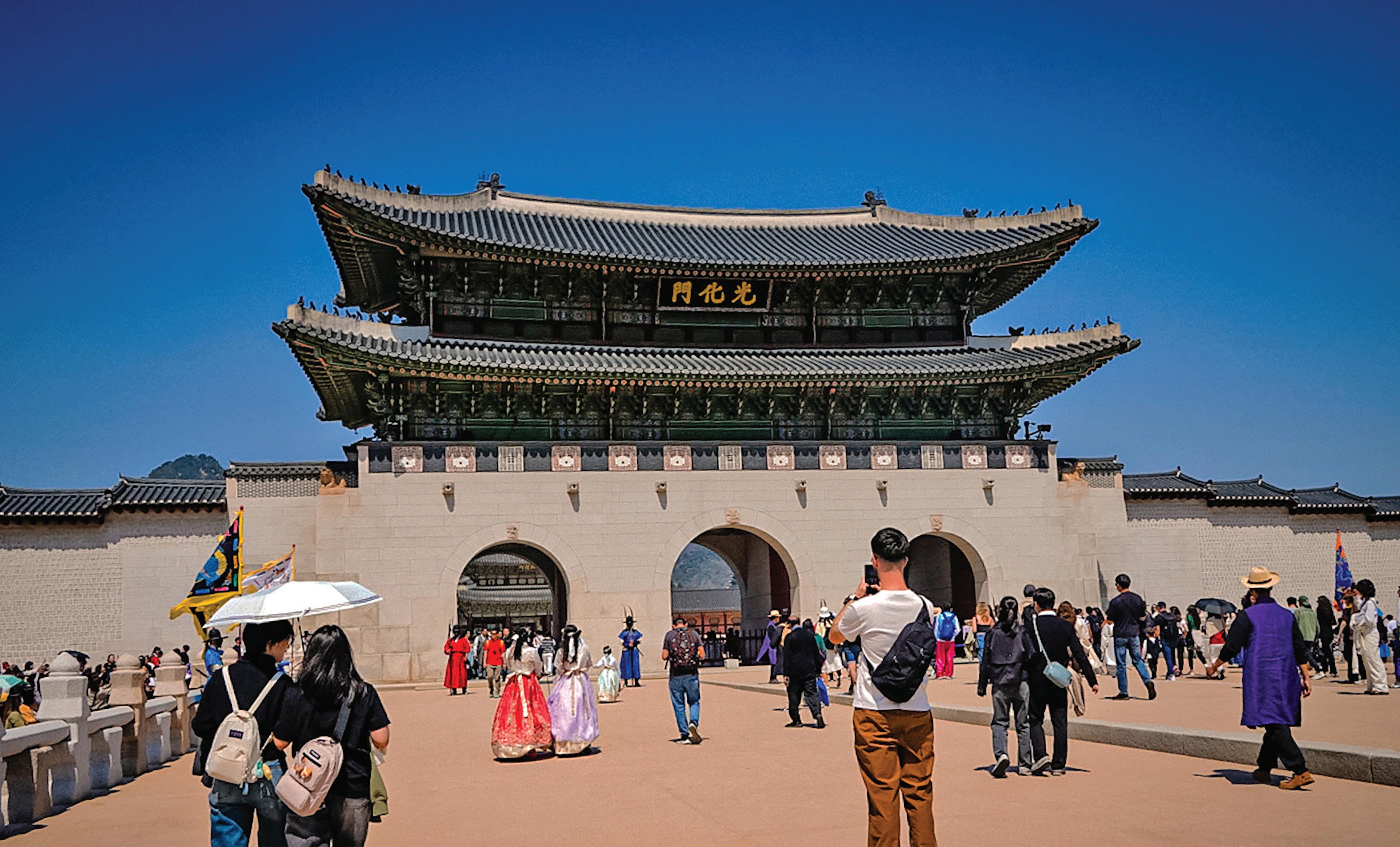

By Joel C. Paredes
THANKS to the global popularity of K-pop and K-dramas, Seoul has become a coveted destination for fans of all ages eager to experience the locations where they’ve seen their favorite stars on screen.
South Korea’s capital has witnessed a surge in foreign visitors, including Filipino tourists, who now feel a strong connection to the glamor of Korean culture and cuisine. In the Philippines, although “everything K” had already been gaining traction for some time, the lockdowns during the Covid-19 pandemic significantly broadened its popularity across all social classes, extending beyond just household help and the younger generation.
Many consider the late 1990s as the beginning of a “cultural diffusion” when the 1997 Asian financial crisis and military censorship over South Korean entertainment came to an end. This allowed South Korea to become a major exporter of popular culture, particularly into neighboring countries like Japan and China.
Such artistic excellence of Korean culture, however, didn’t develop overnight. The Korean Cultural Center in New York cites the original sensitivity of its people reflected in the diverse artifacts and tomb murals of the Three Kingdoms, Seo Unified Silla, Goryeo, and Joseon periods. This sensitivity reportedly deepened as the country progressed through the popular Korean dramas. For instance, riding on the popularity of period dramas, it is now common to see locals and visitors wearing traditional hanboks as they roam around historical sites, including Gyeongbokgung— the first royal palace of the Josen dynasty established in 1395, inspired by what they’ve seen in their popular TV drama series. Clothing rental shops have mushroomed all over the city, offering these colorful outfits for rent, ranging from an hour up to a full day.


For an ideal stay in Seoul, I didn’t look any further than Myeongdong district, renowned as a bustling hub for shopping and delicious Korean cuisine in capturing Seoul’s modern urban life and romantic settings. I admit that I nearly lost my way returning to the hotel, utterly mesmerized by the seemingly identical structures along Myeongdong’s well-paved roads, which felt straight out of countless “romcoms,” or romantic comedies.
A common denominator for most visitors is their desire to catch a glimpse of the places they found memorable after watching their favorite K-dramas.
Fortunately, these filming locations are spread throughout Seoul, allowing tourists to explore different parts of the city.
On busy days, hundreds of fans scramble to take the subway—the most efficient way to reach their destinations—since hailing a cab can be difficult, especially when competing with locals for rides.
Living the K-drama MEANWHILE , the cherry blossom flowers are now thinning, indicating that the highly sought-after Sakura trees that lined the streets and public parks around the city are nearing the end of their bloom


in spring and preparing to fade as summer approaches. Cherry blossoms are indeed a common and beautiful backdrop in many Korean dramas, often associated with romance, spring, and fleeting beauty. The rain also often adds a special something to these scenic views, particularly when the weather is cool and rainy.
It’s as if the borders between screen and reality blur, and they’re no longer just watching, but living the K-drama. Consider the experience of Hans Oliver, whose first time in Seoul felt surreal. He and his for-
By John Eiron R. Francisco
THE Philippines is experiencing growing demand for digital infrastructure, with more largescale data centers expected to rise across the country in the coming years, according to an industry expert.
Paul Churchill, Vice President and General Manager for Asia at Vertiv, said on Wednesday that while markets like Singapore, Hong Kong, Japan, and Korea once dominated data center growth, activity has now surged across Southeast Asia—including Indonesia, Malaysia and increasingly, the Philippines.
“We’re seeing more and more demand for the Philippines as well,” Churchill said, noting that major developments are now taking shape across the region. Indonesia, for instance, has experienced rapid expansion over the past five to six years, while Malaysia is also witnessing heightened activity.
The Philippines, he added, is steadily gaining momentum, reflecting a broader regional shift toward digital infrastructure investment.
Given this growth, Churchill said it is crucial for the Philippines to prepare not only by developing more physical infrastructure but also by building a highly skilled and future-ready workforce.
“It’s about making sure that we have the engineers who understand how to build, operate, and maintain these facilities for the long term,” he said. Churchill made the remarks during the inauguration of Vertiv’s new state-of-the-art training academy in Mandaluyong City, the company’s flagship facility in Asia.
The 337.62-square-meter academy, located inside Mega Tower, serves as a key part of Vertiv’s broader push to enhance engineering capabilities in the region.
“We got to learn and under-

stand the uniqueness of the Philippines and what the Philippines could offer us,” Churchill shared, explaining that the decision to establish the hub in the country was

driven by a combination of factors: its strategic location, growing infrastructure, and a deep pool of engineering talent.
More than 1,200 employees are now based in Vertiv Philippines, supporting not only domestic and regional operations but also the company’s global network. “There’s a very strong affiliation between Vertiv and the Philippines,” Churchill emphasized.
Beyond business process outsourcing (BPO), Vertiv is doubling down on what Churchill called “high-value engineering.” The new facility, he said, reflects the company’s vision of the Philippines not merely as a back-office center, but as a core contributor to the technical development of Asia’s digital future.
become a fad among Filipinos, with numerous restaurants serving the unlimited version.
An emerging affluent society SEOUL , beyond being the center of the “Hallyu” wave, which describes the global phenomenon of the increasing popularity and influence of South Korean culture, has also become a trendsetting center for fashion, largely influenced by the colorful outfits of Korean superstars and music icons.
Apart from conventional tourist attractions like palaces and temples, a new wave of entertainment tourists is being seen at destinations like the “Gangnam Style” statue, which immortalizes Korean rapper and singer Psy’s leg-
“That’s how we want to position our operations here in the Philippines and in this office in particular,” Churchill noted. “It’s not just a call-center mentality, and it hasn’t been like that for Vertiv for many years.”
To meet the sector’s evolving needs, Vertiv is actively collaborating with local universities to align engineering education with realworld demands. Churchill underscored that it is the responsibility of industry leaders not just to serve their own interests but to uplift the entire digital ecosystem.
“As the skill base intensifies, it’s more important for us to continue to invest more and more within the education of the skill levels,” he said. “That’s our responsibility as a dominant player within the indus-
endary “horse-riding” dance music, the first YouTube video to hit 1 billion views. Located near COEX Mall’s entrance, it’s a must-see for K-pop fans and pop culture lovers.
If only to make this land of make-believe more enticing, right inside the mall is the Starfield Library, boasting a collection of 50,000 books and magazines displayed on towering shelves. While the sight of crowds entering the library might seem puzzling, it turns out this seemingly chaotic hub is not intended as a traditional library but more of an art installation.
Gangnam is even more special than the iconic beat. It’s truly a district where South Koreans can display the affluence their society has achieved, especially considering the nation’s rapid economic rise from one of the last Asian countries to emerge as a first-world nation in the latter half of the 20th century.

try—to help support the industry rather than just ourselves.”
‘Hyperscale surge’ WHEN asked which sectors are currently experiencing the fastest growth, Churchill pointed to the hyperscale segment as the primary driver of today’s data center market.
“Largely, it’s the hyperscale,” Churchill said. “So what’s really driving a lot of the data center market at the moment is the hyperscale—companies like Amazon, Microsoft, and others. A lot of the expansion right now is focused in that area.”
He also noted that while hyperscalers lead the surge, telecommunications companies are increasingly moving into the data center space as part of their broader digital transformation efforts.
David Yao, General Manager, Manila Hub, highlighted that the rapid rise in artificial intelligence (AI) applications is fueling this surge in demand.
“What we’re seeing is a lot more demand driven by AI. And it’s more than just ChatGPT,” he said. “Organizations like Vertiv are using AI to become more efficient across processes, manufacturing, and nearly every aspect of the business.”
He noted that every day brings new applications for AI, pushing demand for digital infrastructure even higher. “That demand just keeps increasing,” Yao said, emphasizing that Vertiv is actively investing in talent with AI expertise to explore how these technologies can be leveraged internally.
This AI-driven momentum, Yao explained, ultimately flows into the hyperscale space—further amplifying the need for advanced, large-scale data center infrastructure across the region.
This contrasts sharply with countries like the Philippines, which faced economic struggles in the subsequent decades.
While some may have overlooked it, the tourism industry fueled by the global Hallyu phenomenon has also led to a surge in prices for food and popular items in Seoul’s main urban centers, directly impacting tourists.
However, the authentic everyday life of Seoul can still be experienced in its working-class districts, areas that have yet to be fully explored and integrated into the growing entertainment pilgrimage.
The city’s outskirts boast wellknown markets, a mix of traditional and modern, that have served as backdrops for popular films and television shows. These markets provide a wide range of experiences, from shopping for clothes and cosmetics to sampling street food and discovering unique goods.
Among them, Namdaemun, Korea’s oldest traditional market, stands out for offering goods primarily made by the vendors themselves.
Observers often attributed the global success of the Korean entertainment industry to significant government support aimed at promoting it. However, the ingenuity and creative vision of the Hallyu proponents cannot be undermined, even if some cynics view their approach as a formulaic template that resonated across diverse cultures.
Regardless, the Korean experience offers valuable lessons for the vibrant Philippine entertainment industry, which possesses immense potential to achieve international recognition with the right strategies.
Editor: Angel R. Calso

WBy Sri Taylor & Aaron Gordon
HEN Covid-19 broke the US economy, the trains and buses that carried millions of Americans to work every day emptied out. A $70 billion lifeline from the federal government kept them going—a bet that someday they would again be packed with commuters.
Five years later, that day has come. Workers and tourists are back on the rails and roads. Throngs of straphangers stand shoulder-to-shoulder on the subway. Finding a seat on a crowded rush-hour express train feels like a small victory.
For transportation systems from New York to Chicago to San Francisco, it should be a moment to exhale. Faced with extinction, they survived.
Yet there has been no time for celebration.
No longer flush with emergency aid, the biggest systems are facing a combined $6 billion shortfall for years to come, according to an analysis by Bloomberg News. While ridership across the country has improved, it hasn’t yet returned to its pre-Covid peak.
That’s a big problem for services that rely on the fares paid by riders to fund their operations. To close the gap, many mass-transit authorities are preparing to increase fares, cut service, or both — steps that transit advocates fear could lead to a “death spiral.”
“When transit isn’t frequent and when transit isn’t reliable, people stop using it,” said former Pennsylvania Department of Transportation Secretary Leslie Richards, now a professor at the University of Pennsylvania Stuart Weitzman School of Design.
Shifting political and economic winds are amplifying the challenges. The Trump administration is drastically reining in federal spending, creating fear of job losses that could again decimate ridership. And tariffs could fan inflation, leaving riders less willing—or able — to swallow higher fares. The accumulating pressure has transit agencies worried not only about their capacity to upgrade aging infrastructure, but even to keep buses and trains running for the riders who count on them. Cuts to service raise the risk of longer commutes, lost work hours and clogged roads, as well as a setback to the fight against climate change as more people turn to driving. Few services are under more financial pressure than the Southeastern Pennsylvania Transportation Authority, which serves commuters in Philadelphia and its suburbs. The system is hurtling toward a projected structural deficit of $213 million.
State lawmakers have previously refused to enact proposals from Governor Josh Shapiro to increase the share of sales-tax proceeds allocated to mass transit, which would provide a backstop for fare revenue. Shapiro’s latest budget
proposal includes $1.5 billion in mass-transit funding over the next five years.
Transportation advocates have been sounding alarms about SEPTA’s finances for years. The agency reduced its budget gap by $27 million by freezing salaries for roughly 1,300 of its employees. It plans to propose a fiscal 2026 budget that cuts service by 45% while boosting fares 21.5% starting in September. The cuts would lead to the elimination of 50 bus routes, five regional rail lines and Sports Express trains, according to SEPTA. “There is nothing left to cut from the budget but service,” SEPTA says in large, red type on a website it set up to explain its funding issues to riders. The proposed fare increases would be the system’s largest ever, “by a long shot,” according to Scott Sauer, SEPTA’s interim general manager.
The situation could feed the spiral of declining use transit advocates fear.
“That will erode the operating money that is coming in,” said Richards, the former transportation secretary. “Every time you make a decision to save money, either on the capital side or on the operating side, you’re going to lose.”
System-wide data shows SEPTA ridership in March was 80% of pre-Covid levels. At a board meeting in late March, Sauer warned that if SEPTA is forced to cut service, “all these efforts that we are making to improve service will be disrupted and it will be extremely difficult to reverse course.”
Sauer said the “cuts do not have to happen” if the state legislature backs Shapiro’s plan. Shapiro’s office didn’t respond to a request for comment.
The federal government is unlikely to step in with an additional lifeline. President Donald Trump has sought to rein in government spending and US lawmakers are looking for savings to help finance an extension of Trump’s first-term tax cuts.
“Literally no one has any expectation of Congress doing anything else for them,” said Yonah Freemark, principal research associate at the Urban Institute. “A lot of folks are worried that the Trump administration will try to claw back transit dollars. And if that happened, their situation would get even worse.”
US transit agencies are in a trickier spot than international peers, which generally enjoy higher usage, lower construction costs and more consistent government support. Transport for London’s
ridership stands at approximately 85% of prepandemic levels; it no longer required government subsidies to compensate for lost ridership starting in 2024. Paris is faring better, with ridership almost fully back to where it was before Covid. Both London and Paris opened major new subway lines, in 2022 and 2024, respectively, which helped attract new riders.
Canadian transit agencies have recovered more than 90% of revenue excluding subsidies and more than 80% of ridership compared with pre-pandemic levels, according to Statistics Canada.
In the US, political clashes could compound mass transit’s financial challenges.
The Metropolitan Transportation Authority, which operates New York City’s subways, buses and commuter rails, faces potential operating deficits of about $400 million in 2027 and 2028. The MTA needs state and federal money for infrastructure upgrades to improve service and attract more riders. Its 2025-2029 capital plan relies on an anticipated $14 billion of federal funds.
The MTA is also counting on a congestion-pricing toll to finance service improvements and upgrades. The $9 fee to drive into certain parts of Manhattan is expected to raise $15 billion—yet US Transportation Secretary Sean Duffy is seeking to end the program, and has threatened to withhold federal transportation funding if it continues. The MTA sued the Transportation Department in February after Duffy withdrew federal approval for the toll.
The MTA’s capital program “must be fully funded to carry out critical work that will keep the system running and canceling congestion pricing has serious consequences,”
Kevin Willens, the agency’s chief financial officer, said in a statement. “More broadly, unpredictable federal transportation policy harms the MTA and municipalities across the country.”
New York draws roughly half a million commuters every day from nearby suburbs in New Jersey and Connecticut. New Jersey Transit, which received about $4.4 billion in Covid relief, gets $850 million in federal formula funds annually. Competitive grant awards brought its total to just over $1 billion in fiscal 2025. Any freeze in federal funding could be devastating, officials said.
“Imagine what an existential crisis it would be if I’m not able to pay the staff, if I’m not able to advance projects,” NJ Transit Chief Executive Officer Kris Kolluri said in an interview. “That would have a crippling effect on not just the Northeast Corridor, but the entire nation’s infrastructure.”
To help tackle the system’s fiscal challenges, New Jersey Governor Phil Murphy enacted a corporate transit fee last year that is the first dedicated state funding source for NJ Transit in its history. The surcharge, which is expected to generate $815 million in revenue in fiscal 2026, will supplement a 15% fare increase that took effect last summer and annual 3% fare hikes thereafter.


Transit officials across the nation are confronting similar squeezes. San Francisco’s Bay Area Rapid Transit is on track to use up its roughly $2 billion in federal and state emergency aid by spring 2026.
Faced with a drop in ridership that it expects to never fully recover, BART likely will need to overhaul its funding model. Fares and parking fees once paid for 70% of operating costs before Covid, but now, they cover only 25%. BART said in a statement in March that it had eliminated a projected $35 million budget deficit for fiscal 2026 by reining in costs, but structural deficits of $350 million to $400 million will remain in the years to follow “unless long term stable funding sources can be identified.”
“I can’t remember a situation where it’s been this dire,” BART General Manager Bob Powers said in an interview.
In Chicago, a $770 million budget gap currently looms over the area’s three transit systems, which average about 1.2 million daily rides combined in northeast Illinois.
If the city can’t scrounge up funding to fix it by the end of the legislative session in May, service cuts of as much as 40% are possible. Officials from the Regional Transportation Authority are pushing for an annual injection of $1.5 billion in additional operating funding from the Illinois legislature, along with a 10% fare increase.
Moody’s Ratings revised its outlook in March on the Chicago Transit Authority’s debt to negative, saying it doesn’t expect that the CTA, which runs the city’s “L” train service and buses, can close its operating deficit with spending cuts and fare increases alone. Kroll Bond Rating Agency cut its outlook on CTA’s debt to negative from
stable this month.
CTA didn’t respond to request for comment.
Boston is also facing acute transit-funding issues. Governor Maura Healey has proposed an additional $500 million boost for the Massachusetts Bay Transportation Authority, the agency that runs the cashstrapped subway system known as the “T.”
While that would help the agency balance its operating budget in the upcoming fiscal year, the deficit is projected to balloon to nearly $500 million by fiscal 2028, according to pro forma forecasts shared in
February. The MBTA also needs at least an estimated $24.5 billion to bring its infrastructure to a state of good repair.
The system that serves the heart of the federal government, the Washington Metropolitan Area Transit Authority, could face financial woes due to the Trump administration’s spending cuts. Federal workers make up much of the Metro’s ridership, but the District of Columbia is expected to lose as much as 21% of its workforce.
The financial pitfalls risk leaving transportation systems unprepared to serve not only commuters, but also tourists.
About half the nation’s major public transit systems need to prepare for the FIFA World Cup, which is expected to bring millions of international visitors to the US next year and place big demands on transportation infrastructure. Looming service cuts could make that all but impossible.
“The simple fact is we can’t do it,” said SEPTA’s Sauer. Boston, Philadelphia, San Francisco and New Jersey are all hosting matches. “We won’t be able to handle the influx of people that we’re going to see.” With assistance from Michelle Kaske/Bloomberg
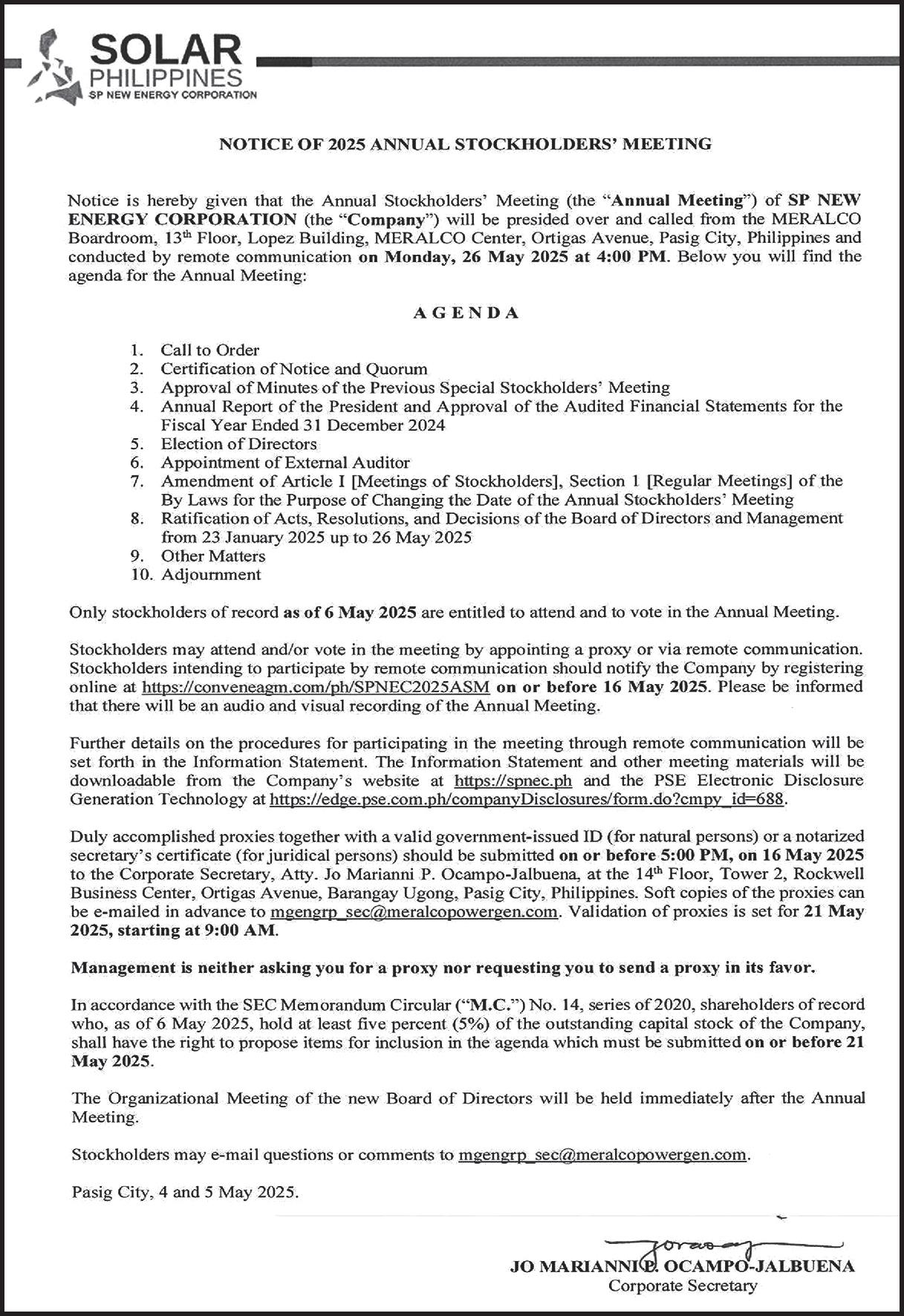
By Siraj Datoo
DONALD Trump’s executive order dismantling diversity, equity and inclusion efforts is making waves at international companies in Europe, Asia and beyond—but only on the surface. Quietly, many businesses are standing firm on diversity initiatives.
Companies from Roche Holding AG to Nissan Motor Co. have backpedaled on DEI policies in the US. But the Swiss drug maker says it has no plans to change its inclusion efforts elsewhere, while the Japanese car maker has left its international websites untouched. Volvo AB is going further: The car company hires “based on meritocracy, not quotas,” its spokesperson said, adding that positive action schemes such as its tecHER program will continue.
It’s what you might call DEI by stealth—an approach that, in various forms, has started to become the new normal for global companies outside the US since President Trump issued an executive order on Jan. 20 entitled “Ending Illegal Discrimination and Restoring Merit-Based Opportunity.”
For American companies, there’s a degree of uncertainty around the directive. While US federal agencies and their suppliers are required to end any form of what Trump calls “illegal DEI,” such as affirmative action in hiring, the order doesn’t definitively say what measures companies are no longer permitted to take. And with robust federal antidiscrimination statutes still in place, it’s not even clear that the directive is lawful.
Outside of the US, the picture is even more complicated. Companies may wish to avoid unwanted scrutiny from the Trump administration, but complying with the spread of international diversity regulations is non-negotiable.
In jurisdictions from the UK
and the EU to Australia and Hong Kong—where inclusion measures have primarily focused on gender rather than race— companies are legally required to meet targets for board diversity, gender pay gaps, pay transparency and reintegration of employees after long-term leave. Various countries have other requirements too. In Japan, top publicly listed companies must aim to promote women to 30% of director roles by 2030, up from about 16% last year. In the Netherlands, the financial sector is expected to consider accessibility to ensure older people are not cut off from basic services.
Nevertheless, few companies want to put their head above the parapet in the US, especially those with lucrative government contracts to lose. On top of the executive order, the president’s demand that US government agencies identify as many as nine potential civil compliance investigations in the private sector lit a tinderbox. No company wants to be the first to be accused of breaking the law.
More than 15 US companies have already altered language around diversity in their annual reports, while European companies are increasingly avoiding the topic on earnings calls.
“Ultimately, people are trying to pivot. They’re trying to keep up with what’s going on but without losing sight of that ultimate goal of inclusive workplaces,” said Zamena Ladak, senior vice president for DEI and business development at Assemble HR Consulting, a New Jersey-based talent strategy

and leadership development consultancy.
Bloomberg contacted more than a dozen companies with headquarters around the world that make a significant portion of their revenue in the US about their diversity, equity and inclusion plans. Few issued a public statement. But it’s clear that boardrooms are under increasing pressure—from lawyers as well as staff—to work out how to tread the DEI tightrope.
Legal obligations
SUPPORTERS argue that DEI strategies are about business survival and economic growth, as well as benefits for individual workers. Companies with more gender diversity are more likely to innovate, according to research published in the journal Innovation: Management, Policy & Practice. However, while many firms say they have recruited without bias for decades, few can boast a representative workforce—in fact, many initiatives have led to even more homogeneity, according to analysis by academics Frank Dobbin and Alexandra Kalev. Countries where a significant portion of women are economically inactive or underactive are missing a growth opportunity, a particular problem for countries with an aging or shrinking population such as Germany, Spain, Italy, Japan and South Korea. In Japan, where a third of the population will be over 65 years old by 2040, the economy is already suffering, while Germany needs an influx of hundreds of thousands of migrant workers a year simply to prevent its labor force from shrinking.
By helping companies close the gender pay gap and finding other ways to make the workplace more equitable, DEI teams help to keep women working or increase their hours, according to a 2020 report by Mercer Inc.
They can help companies meet their legal obligations too. In the UK, companies’ responsibilities include avoiding discrimination in hiring and taking “reasonable steps” to prevent sexual harassment.
Doing so effectively means firms need to educate staff about what discrimination, harassment and victimization—which can be subtle or inadvertent—look like.
“Having DEI programs helps them comply,” said Georgina Calvert-Lee, an employment lawyer at Bellevue Law.
But training on controversial topics like unconscious bias has in some cases already been rebranded. Now, there’s “less emphasis on this idea that we’re all biased or terrible people,” said Kate Dodd, an employment lawyer at Pinsent Masons and head of the firm’s Brook Graham diversity and inclusion consultancy. Instead, the focus is on using data to examine why specific minority groups may progress through a firm more slowly or exhibit higher attrition rates.
Many international companies are viewing the DEI retreat in the US through the lens of a four-year presidential term, according to Alexandra Evreinoff, managing director at INvolve, a London-based diversity and inclusion consultancy that has worked with clients such as Boston Consulting Group, HSBC Holdings Plc and Standard Chartered Plc.
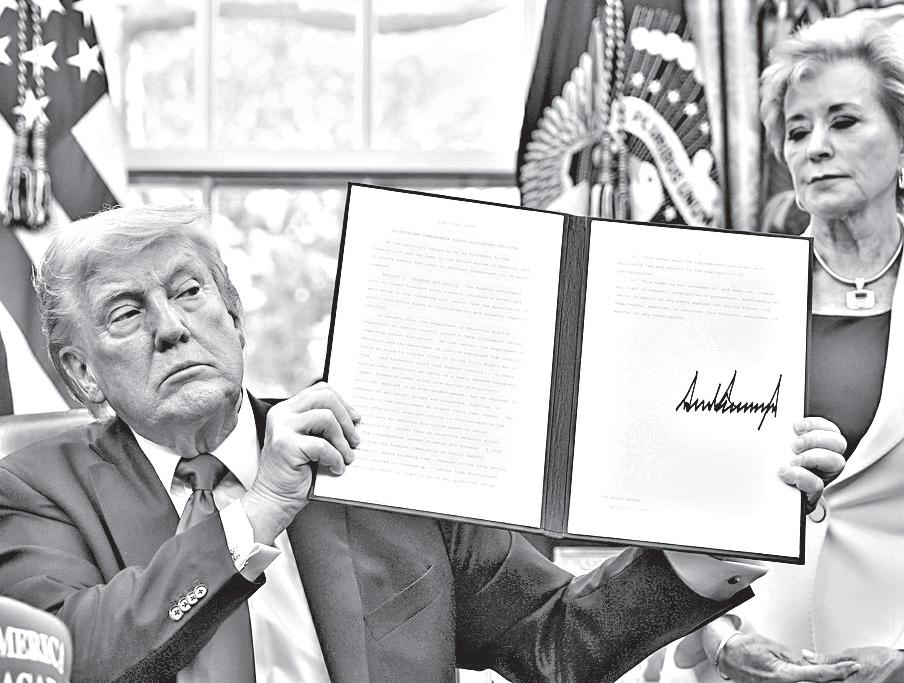
Two large European multinational companies that work with the federal government told Bloomberg they won’t alter DEI policies unless the executive order is enforced. The move is seen as being in the best interests of customers and staff, according to a person familiar with the matter who did not wish to speak publicly for fear of reprisals.
While Sumitomo Mitsui Financial Group Inc. wiped references to DEI from its American websites, the Japanese company left its international websites untouched, describing the US changes as part of a global digital restructure “after many months of planning.” UBS Chief Executive Officer Sergio Ermotti said last month that the Swiss bank was making no changes to its DEI policies—but its sustainability and annual reports, published Monday, no longer refer to “DE&I.”
And several banks headquartered outside the US, such as HSBC, Deutsche Bank AG, Barclays Plc and Banco Santander SA, have publicly reaffirmed their commitments to DEI and workforce representation targets, even as some Wall Street banks have backpedaled. In its annual report, HSBC described having a workforce that reflects society as a “strategic priority.” In January, Deutsche Bank CEO Christian Sewing called DEI “integral” to the company.
“I know what diversity has brought us on the management board at the top reporting level,” he said. “That’s why we are strong supporters of these programs.”
In fashion and retail—sectors where women make up an important part of the consumer base—companies including Germany-based Adidas AG, Hennes & Mauritz AB and Ikea have explicitly retained their DEI focus. “Our commitments in this area remain unchanged and are closely connected with our company’s purpose,” a spokesperson for H&M said.
Some European pharmaceutical companies are pushing on too with a commitment to inclusive clinical trials, according to people familiar with the situation. Their position is grounded in science as well as business: Testing the efficacy and side effects of new products requires women and individuals from underrepresented groups to take part in drug trials.
“We need to have a continuous focus on this,” Martin Holst Lange, Novo Nordisk A/S’s development chief, said this month. It’s also important to include patients of diverse socioeconomic status, he said.
In other sectors, the outlook
A 2024 survey by campaign group Reboot found that about 40% of respondents at financial services firms said budget cuts had hampered DEI efforts.
“This is where we see who was really committed to diversity, equity, inclusion and for whom this was a matter of compliance,” said Michael Smets, professor of management at Oxford University’s Saïd Business School.
Sense of unease IN the UK, diversity-focused roles in human resources departments, while below a peak in 2020, have remained steady since 2022, according to the job search website Indeed.
is more mixed. Consulting giant McKinsey & Co. sent a carefully crafted memo to staff emphasizing that the company is still focused on inclusion, while noting that it abides by local law—a strong hint that it’s complying with anti-DEI measures in the US.
Deloitte looked ready to drop its diversity policies globally before its partnerships in the UK and Australia said they wouldn’t make any changes locally. Meanwhile, Accenture Plc was among the first nonUS-headquartered companies in any sector to ditch its global DEI policies. All three have a lot to lose by defying Trump. Their combined revenues as federal government contractors were in excess of $7.8 billion in the fiscal year to Sep. 30, according to Bloomberg data.
Conservative activism WHILE companies are now scrambling to find the right language to describe their plans around diversity, equity and inclusion, the president’s crusade can’t have come as a total surprise. During his presidential campaign, Trump railed against “antiWhite racism” and “illegal” DEI measures. A blizzard of conservative activism and lawsuits also raged in the leadup to the elections.
In 2023, the Supreme Court effectively ended affirmative action concerning race in college admissions, after lawyer and anti-affirmative action activist Edward Blum sued Harvard. Even though the ruling didn’t extend to businesses, it created a chilling effect around racerelated measures in recruiting.
The Supreme Court is now hearing a discrimination case brought forward by a White woman who claims she was first denied a promotion and then later demoted because she is heterosexual. If successful, the case could pave the way for more discrimination suits from members of majority groups.
In the short term, lawyers are urging global companies with an American presence to “hit the pause button” on any programs in the US that might benefit specific demographics, according to INvolve’s Evreinoff.
Global companies are looking for “a good balance between the regional approach and the global strategy,” said Evreinoff, given the legal requirements they still have to meet abroad.
Even so, in the UK at least, conversations with professionals in DEI-related roles indicate a subtle shift has taken place over the past two years. The country is among the most advanced in terms of DEI development, but a worsening economic outlook has led to something of a pullback.
But the number of senior roles, particularly chief diversity officer, has “fallen off a cliff in EMEA” over the last 18 months, according to Raj Tulsiani, CEO of Green Park, a UK-based recruitment firm that specializes in more equitable leadership. And DEI teams have shrunk at many firms, according to Pinsent Masons’ Dodd.
Right-leaning UK newspapers such as the Daily Mail and the London-based Times have described DEI roles in public organizations such as the police or universities as wasteful spending. Kemi Badenoch, the leader of the opposition Conservative party, last month described diversity programs as “the real poison of left-wing progressivism.”
Given the pace of the retreat in the US, it remains to be seen what the next 12 months will look like for diversity, equity and inclusion around the world. In an interview, conservative activist Robby Starbuck, who has pressured a number of US companies to cancel inclusion programs, called DEI and ESG policies “anti-Western” and suggested that he has broader ambitions overseas. “We pushed this out there and it’s our responsibility to bring it back in,” he told Bloomberg. Yet the US and other countries may be on a path to diverge further still. The British government has plans to extend mandatory pay gap reporting to ethnic minority workers, while a series of lawsuits over equal pay promises to force companies to consider gender disparity in specific roles, not just across the business. Meanwhile, companies with EU staff are gearing up for pay transparency disclosures from next summer, which will require firms to address any gaps larger than 5%. Either way, a sense of unease remains pervasive. At one European multinational with a large US presence and a federal contract, there’s a rumor doing the rounds that bots are crawling the websites of private companies, searching for DEI buzzwords that might breach the president’s executive orders. In early February, the company tore down various DEI-related webpages, before reinstating them a few days later, absent some key phrases and terms. Still, the company has no grander plans to change its inclusion strategy.
For a lot of companies outside the US, the focus now is merely “repositioning,” said INvolve’s Evreinoff.
“It would be complete nonsense to say we’re scrapping everything that’s DEI,” she said. “That’s not true.” With assistance from

By Geraldine Bulaon-Ducusin
IN climate change adaptation, there’s a need to think about the reality of the sea level rise, said Dr. Laura T. David, a professor and marine expert at the University of the Philippines.
“Our streets should be way higher than the sea level. The 40-meter easement in the existing law is no longer enough. Climate change was non-existent yet when it was made. Today. with climate change, the goal should be 7 meters higher,” David explained in Filipino during the online dialogue on the “Global Climate Change: Assessing the State of Our Planet.”
The April 25 event was part of the #PilipiNAST Kapehan series being held by the National Academy of Science and Technology (NAST).
David advised that the country’s developments—roads, hospitals, schools— should be 7 meters higher than the current sea level because with the climate change, even with a sea level rise of 1 meter, a storm surge can potentially destroy the infrastructures. When this happens, the country will have to spend again on the materials for development.
The Presidential Decree 1067, s. 1976, also known as “The Water Code of the Philippines,” states in Article 51 that the banks of rivers and streams and the shores of the seas and lakes throughout their entire length and within a zone of 3 meters in urban areas,
20 meters in agricultural areas and 40 meters in forest areas, along their margins, are subject to the easement of public use in the interest of recreation, navigation, floatage, fishing and salvage. No person shall be allowed to stay in this zone longer than what is necessary for recreation, navigation, floatage, fishing or salvage or to build structures of any kind.”
Currently, what’s being followed is still the 40-meter easement, and that’s the horizontal distance, instead of a height distance.
David said that it would be a big help if the legislators will craft a policy, at least on the essential structures for transportation like roads, airports, hospitals, evacuation centers, and schools which are also being used as evacuation centers. These structures should be placed higher than 7 meters.
To illustrate what’s going on in the environment with the climate change, Academician Rodel D. Lasco, an environment expert, explained it this way partly in Filipino: “Let us think of it like a blanket. These gases, such as the carbon dioxide [CO2], methane [CH4], and nitrous oxide [N2O], are

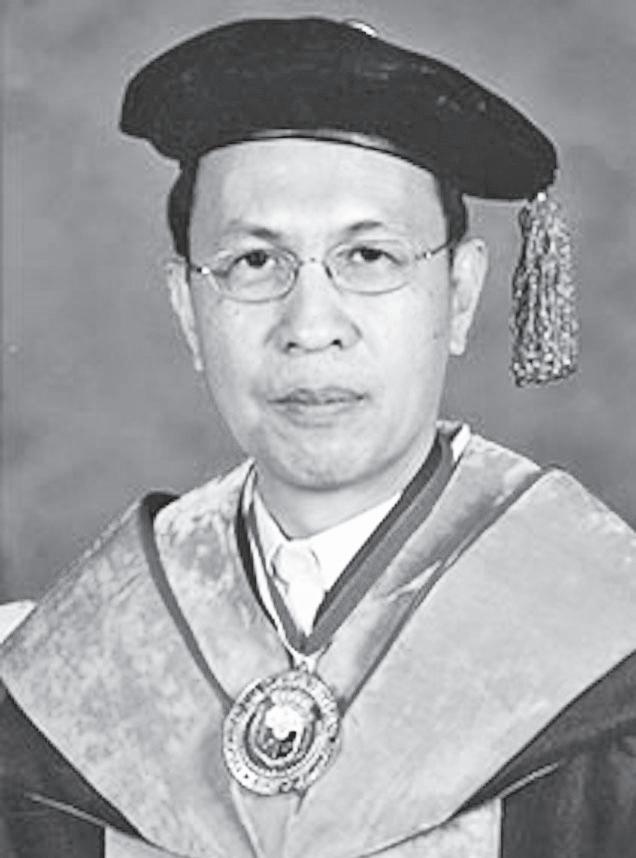
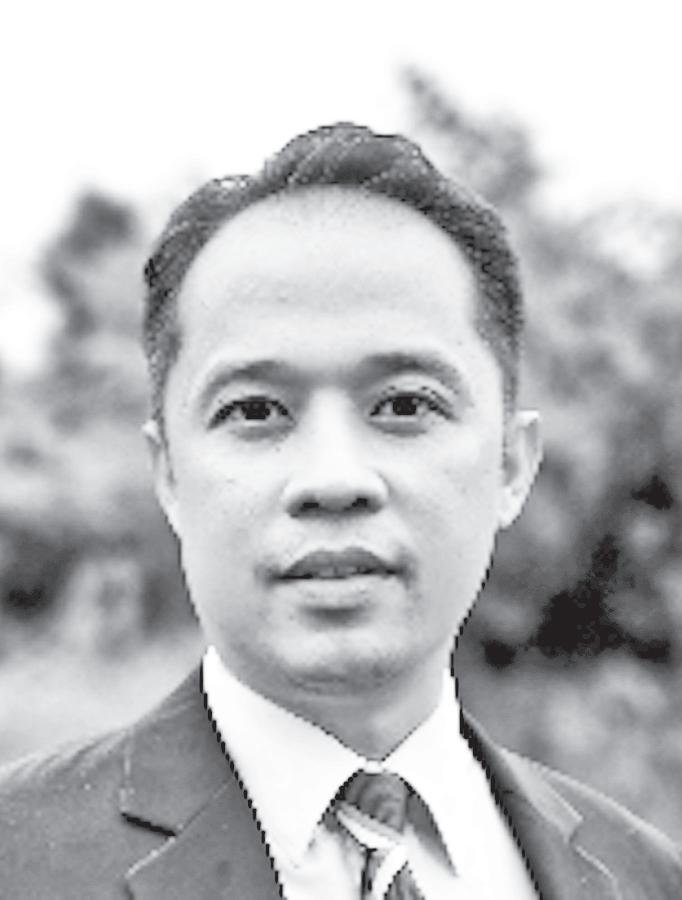
like a blanket, blanketing the earth to keep us warm and comfortable. So they are vey important. However, what’s happening is that we are like blowing out greenhouse gases. In layman’s term, we are like adding to the blanket.”
“So if you are in Baguio, for example, you are comfortable with one blanket, but if you use two, you feel warm, and if you use three, you might perspire and feel uncomfortable. So that’s what’s happening in our planet right now. This is what is called human-induced climate change because it’s beyond the natural variability,” Lasco added.
The globe is fast changing and what’s being experienced now is no longer the natural pace of change and it’s the people who are causing this rapid changes.
Lasco emphasized the importance of the blanket because if there’s no blanket as protection, the temperature may be negative 20 degrees Celsius and the people might feel cold as if they’re on the North Pole.
But, if there’s an excess in blan -

A SCHEMATIC diagram of the experimental setup and a photo (inset) of the actual setup. A glass slide coated with a substrate made of electrospun PVC fibers makes for a hydrophobic surface where water droplets can form spherical domes with useful optical properties. SOURCE: BUDLAYAN ET AL., 2025
FILIPINO scientists have discovered a simple, affordable way to make dynamically adjustable water-based lenses that have a wide variety of potential future applications—from classrooms and research labs to cameras and even wearable gadgets. By coating an ordinary glass slide with specially-prepared polyvinyl chloride (PVC) plastic, the researchers were able to create a hydrophobic surface that could hold a water droplet in a dome shape similar to a magnifying glass. And by adding or removing water from the droplet, they were able to change and control the magnifying power of this liquid lens with minimal loss or distortion.
The research was titled “Tunable Optical Beam Focusing using Static Water Droplets on an Electrospun Polymer Fiber.”
It was led by Ateneo de Manila
University School of Science and
Engineering’s Department of Physics researchers Marco Laurence M. Budlayan and Dr. Raphael A. Guerrero. Colleagues from Caraga State University, Pangasinan State University, and the University of the Philippines Diliman also participated in the research. In a process called “electrospinning,” the researchers melted the PVC in an electric field, which stretches out and deposits the plastic onto the glass slide as very fine microfibers. This makes the surface of the slide more water repellent, and the result is that water droplets stay in a spherical dome shape instead of flattening out.
By placing droplets of different sizes on this surface and shining a laser through them, the researchers observed that the light beam widened or narrowed depending on the droplet’s size.
Larger droplets acted like lenses with longer focal lengths, while
smaller droplets behaved like closeup lenses, with the laser maintaining a clean and undistorted beam. Because it is low-cost, simple to make, and easy to use, this discovery has multiple potential practical applications.
It could be used in science classrooms to teach optics, particularly in schools with limited lab equipment. In remote or low-resource areas, it could help build basic optical tools for experiments or diagnostics.
And even in research labs, it offers a quick way to adjust laser beams. It also lays the groundwork for more advanced liquid lenses for possible use in cameras, microscopes, and even wearable tech. With further development, it might also be used in portable diagnostic devices or small projection and lighting systems.
The findings are published in the May 2025 issue of “Results in Optics.”
kets, the people will feel very warm and that would also have various effects both in the natural and human ecosystem.
One of the manifestations that climate change is real is in the way the roots of coconut trees are now getting visible in the beaches, not just in the Philippines, but in other countries, as well, which was not supposed to be because they are not like mangroves with visible roots. This means that waves are going in many places, eroding the soil, and the sea level is rising.
The strength of the storm comes from the hot temperature of the sea. The greater the sea temperature, the greater chance for the storm to develop. The hotter the sea, the stronger the storm will be.
In the past, when there’s a storm signal No. 5, the storm weakens as they come near the Philippines because of the cold water surrounding the area.
But now, with the hot temperature of the water close to the Philippines, the storm no longer
weakens as they approach and they have become even stronger.
“It’s not an increasing number of typhoons. They are getting stronger and bringing more rains. The rains that we expect within a month are poured out within a few days. That is why many low-lying areas, like agriculture and communities near the shore, even if there is no storm surge, are getting flooded,” David explained. Mangroves expert Dr. Dixon T. Gevaňa suggested strengthening the mitigation efforts, in light of knowing and experiencing the patterns that comes after the extreme heat, when a number of storms lined up, like what happened in November 2024. There should be mitigation preparations, he said.
In the 1970s, there was very limited understanding on what the mangroves can do to protect the environment, so they were sacrificed back then to make way for more fishponds so there will be more food for the people and more shrimps for export to Japan. But now, people know better
how mangroves help in the environment by giving shelter to fishes and their importance in helping ease the impact of storm surge. The current problem, however, as pointed out by David, is the damage to the mangroves as a result of roads being built near the coastal areas.
David said there’s a need to really think about these things as these actions might be exposing the communities, plus the fact that investments will be wasted if they will be damaged by storm surges.
When asked on the urgency, if there’s a timeline for action, the scientists agree that climate change is already an emergency and requires action now.
Based on the Intergovernmental Panel on Climate Change recommendation in 2022, there’s a 10-year window for action and that window’s fast closing now.
“I think like in everyday life, the government has to attend to many concerns. But like when a person gets sick or has an emergency, the attention is focused on one thing. The government has to realize, and all of us need to realize, that this is already a climate change emergency. It is an emergency. And we have to focus to deal with this now. Because if we do not act now, we have to deal with a bigger task in the future,” David advised. David added that she hopes this administration will come up with concrete action, at least policywise, to do something right for adaptation.
PilipiNAST Kapehan has been a regular monthly online dialogue among NAST, academicians and science experts and media, tackling the programs, activities, of the academy, as well as the timely issues of the country.
More study needed for multidrug-resistant ‘Salmonella’ in chicken, UP biologists urge
BIOLOGISTS from the University of the Philippines DilimanCollege of Science, Institute of Biology (UPD-CS IB) call for more in-depth surveillance of foodborne pathogens like the bacterium “Salmonella” in poultry products.
Infections caused by “Salmonella” typically result in symptoms such as fever, abdominal pain, diarrhea, nausea, and sometimes vomiting, which usually appear 6 hours to 72 hours after ingestion, and can last from two to seven days.
The rapid rise of multidrugresistant (MDR) bacteria makes treating bacterial infections increasingly difficult, and the widespread use of antibiotics in agricultural, clinical, and residential environments leave few immediate solutions.
MDR “Salmonella” is widely acknowledged as a major global public health issue, with scientists reporting the bacteria as one of the leading causes of diarrhea and outbreaks worldwide annually, including in the Philippines.
As a large producer and consumer of meat, the Philippines faces a pressing need to monitor these potential threats, and explore the genome of MDR “Salmonella” to identify of its most common types, assess their disease-causing abilities, and uncover circulating ARGs
that pose risks to food safety and public health.
Using whole genome sequencing (WGS) and phenotypic antimicrobial resistance (AMR) testing, Michael Joseph Nagpala, Jonah Feliza Mora, Rance Derrick Pavon, and Dr. Windell Rivera from the Pathogen-Host-Environment Interactions Research Laboratory (PHEIRL) of the UPD-CS IB examined the genetic makeup and AMR of “Salmonella” collected from chicken meat, the second most consumed meat in the country, sold in retail wet markets across Metro Manila.
The most predominant type of “Salmonella” was Infantis, followed by Brancaster, Anatum, London, Uganda, and Derby, all of which possessed diverse virulence and resistance genes.
High levels (more than 45 percent) of multidrug resistance were observed when tested against antimicrobial panels, with a total of 50 ARGs detected, conferring resistance to 12 different drug classes. Numerous plasmids—small, circular DNA pieces that play a vital role in spreading resistance—were also identified in some types of “Salmonella.”
“Our study suggests a need for proper surveillance of contaminating bacteria as well as regulations on
antimicrobial use at the farm level, as infections from MDR “Salmonella,” especially among vulnerable populations and from highly virulent serovars [types of “Salmonella”], can lead to life-threatening, systemic, and untreatable manifestations,” the team said. The biologists further emphasized that there is a clear and significant risk of MDR “Salmonella” variants spreading within wet markets and food animal value chains, as well as the potential for cross-contamination and undetected transmission in kitchens and homes.
“Mitigating this concern requires multi-sectoral policies, regulations, and standards— especially regarding proper antibiotic use, increased awareness of AMR and MDR at the farm, clinical, and community levels, and support for research and development of antimicrobial alternatives, and surveillance of foodborne pathogens and resistance,” the team concluded. The study “Genomic characterization of antimicrobial-resistant ‘Salmonella enterica’ in chicken meat from wet markets in Metro Manila, Philippines” was supported by the Department of Agriculture-Biotechnology Program Office. It is published in Frontiers in Microbiology, 16. https://doi.org/10.3389/ fmicb.2025.1496685.
A6 Sunday, May 4, 2025

By Giada Zampano
VATICAN CITY—“Conclave,” the movie, may have introduced movie-goers to the spectacular ritual and drama of a modern conclave, but the periodic voting to elect a new pope has been going on for centuries and created a whole genre of historical trivia.
Here are some fun facts about conclaves past, derived from historical studies, including Miles Pattenden’s “Electing the Pope in Early Modern Italy, 1450–1700,” and interviews with experts including Elena Cangiano, an archeologist at Viterbo’s Palazzo dei Papi (Palace of the Popes).
The longest conclave in history IN the 13th century, it took almost three years—1,006 days to be exact—to choose Pope Clement IV’s successor, making it the longest conclave in the Catholic Church’s history. It’s also where the term conclave comes from—”under lock and key,” because the cardinals who were meeting in Viterbo, north of Rome, took so long the town’s frustrated citizens locked them in the room.
The secret vote that elected Pope Gregory X lasted from November 1268 to September 1271. It was the first example of a papal election by “compromise,” after a long struggle between supporters of two main geopolitical medieval factions—those faithful to the papacy and those supporting the Holy Roman Empire.
‘One meal a day’ rule GREGORY X was elected only
after Viterbo residents tore the roof off the building where the prelates were staying and restricted their meals to bread and water to pressure them to come to a conclusion.
Hoping to avoid a repeat, Gregory X decreed in 1274 that cardinals would only get “one meal a day” if the conclave stretched beyond three days, and only “bread, water and wine” if it went beyond eight. That restriction has been dropped.
The shortest conclave ever BEFORE 1274, there were times when a pope was elected the same day as the death of his predecessor. After that, however, the church decided to wait at least 10 days before the first vote.
Later that was extended to 15 days to give all cardinals time to get to Rome.
The quickest conclave observing the 10-day wait rule appears to have been the 1503 election of Pope Julius II, who was elected in just a few hours, according to Vatican historian Ambrogio Piazzoni.
In more recent times, Pope Francis was elected in 2013 on the fifth ballot, Benedict XVI won in 2005 on the fourth, and Pope Pius XII won on the third in 1939.
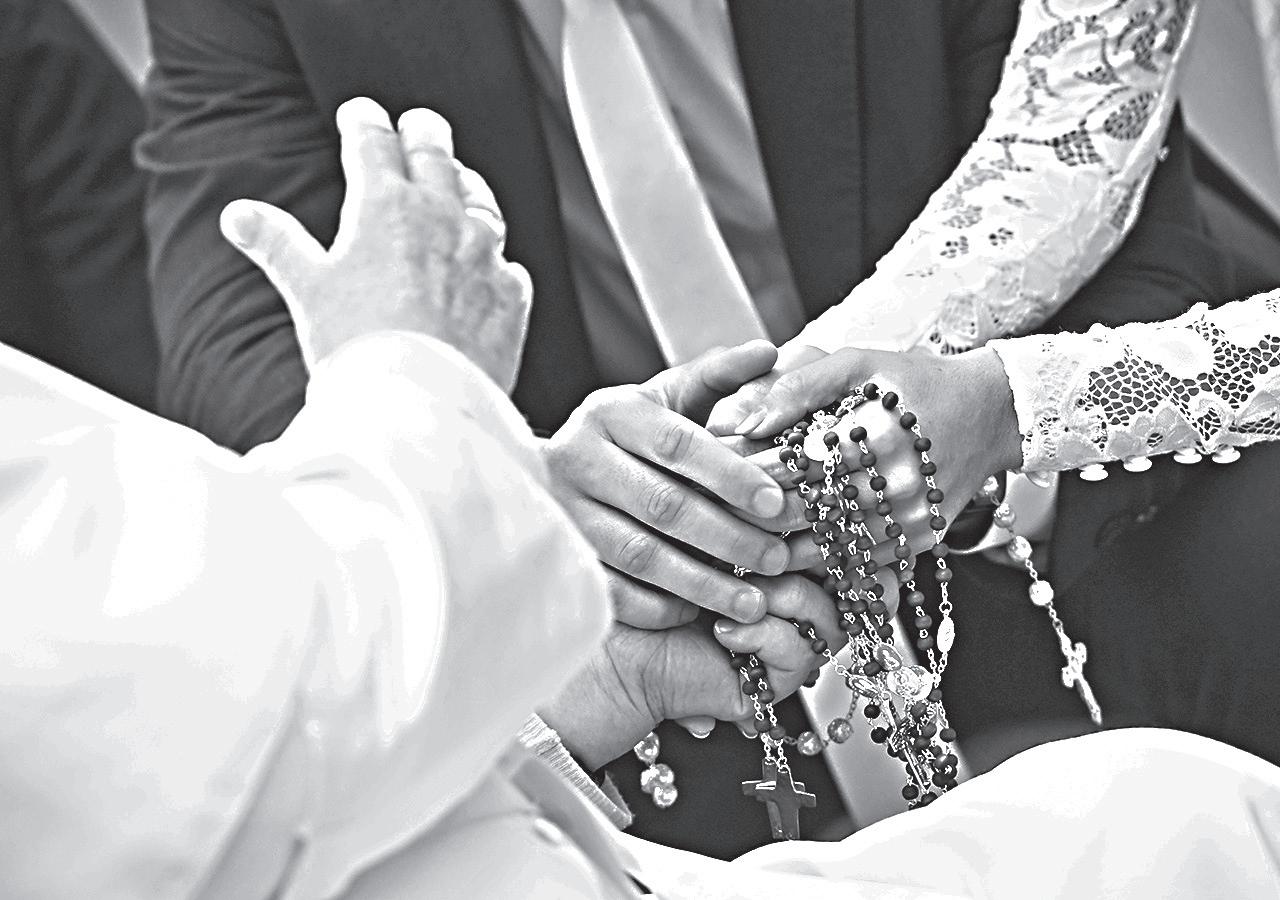
The first conclave in the Sistine Chapel
THE first conclave held under Michelangelo’s frescoed ceiling in the Sistine Chapel was in 1492.
Since 1878, the world-renowned chapel has become the venue of all conclaves.
“Everything is conducive to an awareness of the presence of God, in whose sight each person will one day be judged,” St. John Paul II wrote in his 1996 document regulating the conclave, “Universi Dominici Gregis.”
The cardinals sleep a short distance away in the nearby Domus Santa Marta hotel or a nearby residence.
The alternative locations MOST conclaves were held in Rome, with some taking place outside the Vatican walls. Four were held in the Pauline Chapel of the papal residence at the Quirinale Palace, while some 30 others were held in St. John Lateran Basilica, Santa Maria Sopra Minerva or other places in Rome.
On 15 occasions they took place outside Rome and the Vatican altogether, including in Viterbo, Perugia, Arezzo and Venice in Italy, and Konstanz, Germany, and Lyon, France.
The alternative popes, or antipopes
BETWEEN 1378-1417, referred by historians to as the Western Schism, there were rival claimants to the title of pope.
The schism produced multiple papal contenders, the so-called anti-popes, splitting the Catholic Church for nearly 40 years. The most prominent anti-popes during the Western Schism were Clement VII, Benedict XIII, Alexander V, and John XXIII.
The schism was ultimately resolved by the Council of Constance in 1417, which led to the election of Martin V, a universally accepted pontiff.
accepted without reservations, and those who do not have this experience often— unknowingly—carry a wound for the rest of their lives,” Francis argued.
“Instead, those who enter into a union lose nothing but gain everything: life at its fullest,” he said.
The Holy Father noted that he had urged the Church to “help you build a foundation for your relationship based on God’s faithful love.” He wrote that he “dreamed” of a catechumenate-style marriage formation program for the Church, one that might last years and would “save you from disappointment, from invalid or unstable marriages.”
Pointing to YOUCAT’s marriage formation material as a guide, the pope said couples should “absolutely participate in marriage preparation courses.”
“Before receiving the sacrament of marriage, a proper preparation is necessary,” the pope wrote.
“We cannot continue on as before: Many only see the beautiful ritual,” he said. “And then, after some years, they separate. Faith is destroyed. Wounds are opened. There are often children who are missing a father or a mother.”
Comparing marriage to the dance of tango in his native Argentina, Pope Francis said treating a marriage this way is “like dancing tango poorly.”
“Tango is a dance that must be learned. This is all the more true when it comes to marriage and family,” the late pontiff said.
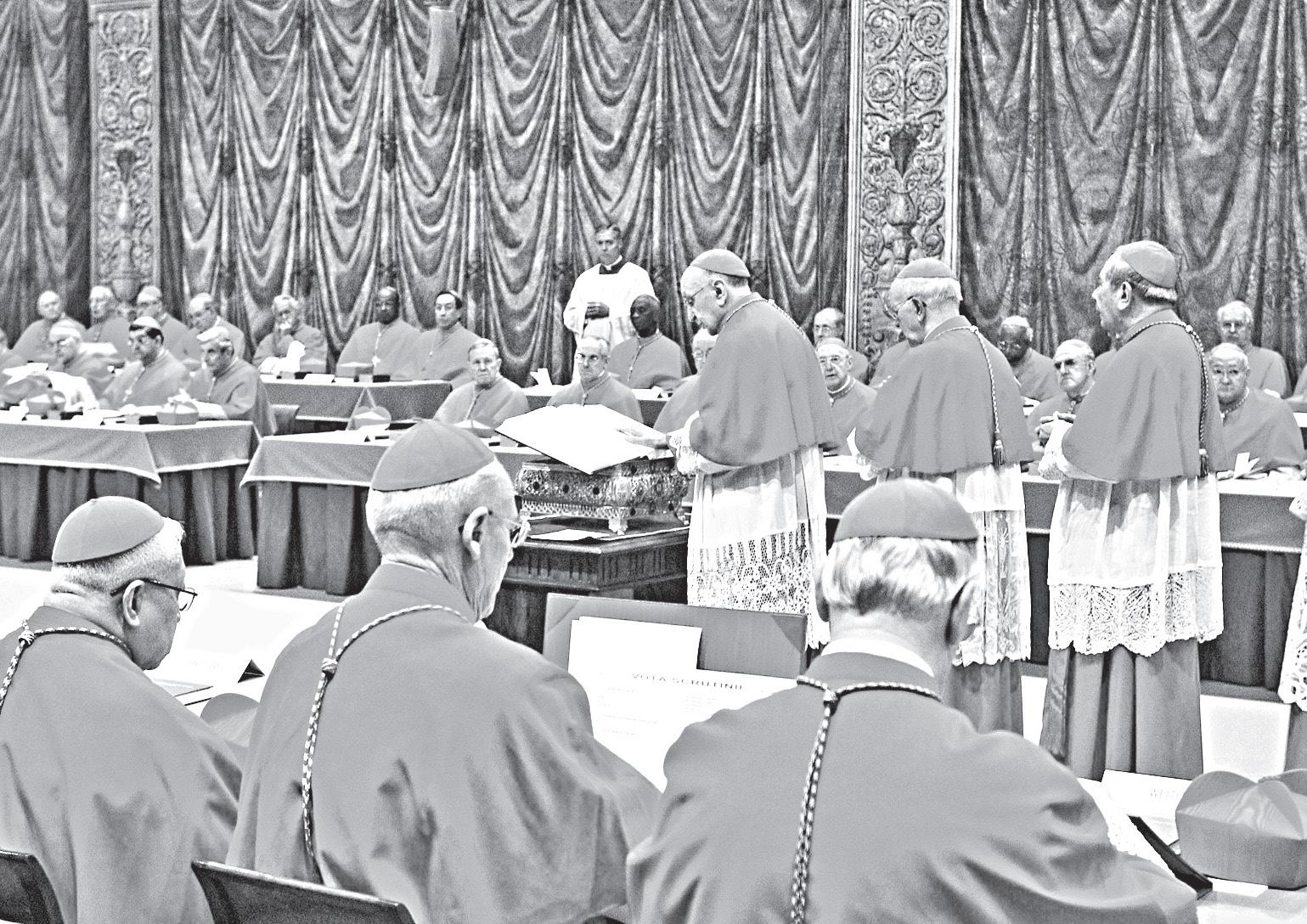
challenge to personal hygiene
THE cloistered nature of the conclave posed another challenge for cardinals: staying healthy.
Before the Domus Santa Marta guest-house was built in 1996, cardinal electors slept on cots in rooms connected to the Sistine Chapel.
Conclaves in the 16th and 17th centuries were described as “disgusting” and “badly smelling,” with concern about disease outbreaks, particularly in summer, according to historian Miles Pattenden.
“The cardinals simply had to have a more regular and comfortable way of living because they were old men, many of them with quite advanced disease,” Pattenden wrote.
The enclosed space and lack of ventilation further aggravated these issues. Some of the electors left the conclave sick, often seriously.
INITIALLY , papal elections weren’t as secretive but concerns about political interference soared during the longest conclave in Viterbo.
Gregory X decreed that cardinal electors should be locked in seclusion, “cum clave” (with a key), until a new pope was chosen.
The purpose was to create a totally secluded environment where the cardinals could focus on their task, guided by God’s will, without any political interference or distractions.
Over the centuries, various popes have modified and reinforced the rules surrounding the conclave, emphasizing the importance of secrecy.
avoid the pain, to touch each other only as though in a passing dance, to enjoy each other, play together, and then leave,” the pope countered that love “until further notice” is not love.
“We humans have the desire to be
Quoting his earlier apostolic exhortation Amoris Laetitia, the pope finished the foreword: “In young love, the dancing—step by step, a dance toward hope with eyes full of wonder—must not stop.” Daniel Payne/Catholic News Agency
VATICAN CITY—A coalition of survivors of clergy sexual abuse demanded that cardinals entering the conclave to elect a successor to Pope Francis pick a pope who will adopt a universal zero-tolerance policy for abuse and himself has a clean record handling cases.
The group End Clergy Abuse (ECA) issued an open letter to the cardinals who are meeting informally this week before the start of the May 7 conclave.
SNAP, short for Survivors Network of those Abused by Priests, the main US-based survivor group, also identified cardinals who themselves have problematic records in a new database, highlighting a new level of scrutiny of all possible contenders for the papacy.
The developments come amid real questions about how prominent the abuse scandal is featuring in the discussions about finding a new pope.
After two decades of unrelenting revelations about abuse and coverup that have discredited the Catholic hierarchy, many church leaders would like to think the issue is in the past, the survivors said.
“The sexual abuse crisis is not a matter of the past. It is present. And nowhere is its devastation more visible than in the Global South,” the survivors said in the open letter.
ECA and SNAP have called for
A non-cardinal pope and nonItalian pope THERE is no requirement that a pope be a cardinal, but that has been the case for centuries. The last time a pope was elected who wasn’t a cardinal was Urban VI in 1378. He was a monk and archbishop of Bari.
While the Italians have had a stranglehold on the papacy over centuries, there have been many exceptions aside from John Paul II (Polish in 1978) and Benedict XVI (German in 2005) and Francis (Argentine in 2013).
Alexander VI, elected in 1492, was Spanish; Gregory III, elected in 731, was Syrian; Adrian VI, elected in 1522, was from the Netherlands. AP
Youngest pope, oldest pope POPE John XII was just 18 when he was elected in 955. The oldest popes were Pope Celestine III (elected in 1191) and Celestine V (elected in 1294) who were both nearly 85. Benedict XVI was 78 when he was elected in 2005.
Abuse survivors demand next pope enact zero tolerance, identify cardinals with poor records
the Catholic Church to adopt a zero-tolerance policy that a priest will be permanently removed from church ministry based on even a single act of sexual abuse that is either admitted to or established according to church law.
That is the policy in the US church, adopted at the height of the US scandal in 2002, but it is by no means embraced elsewhere.
The issue is playing out in real time in Rome as the cardinals gather: Peruvian Cardinal Juan Luis Cipriani Thorne, 81, has been seen in full cardinal garb entering and exiting Vatican City, despite being under Vatican sanction for allegedly abusing a minor.
Cipriani is not allowed in the conclave itself because he is over 80, but he has been participating in the pre-conclave meetings this week.
The Vatican in January confirmed that disciplinary sanctions were in effect against Cipriani, the first-ever cardinal from Opus Dei, following accusations of sexual abuse.
The sanctions included requiring him to leave Peru and included restrictions on his public activity and use of insignia. The Vatican said he was allowed to deviate from them on some occasions.
Asked why Cipriani was presenting himself as a cardinal and participating, Vatican spokesman Matteo Bruni said the Vatican
regulations concerning the preconclave meetings are clear. The rules, he said, all cardinals must participate unless they have “legitimate impediments,” which involve “personal or physical questions.” Cipriani, who lives in Madrid and Rome, has called the allegations “completely false.” Bruni said the issue of abuse was discussed this week by cardinals in the pre-conclave discussions, among other challenges facing the church.
SNAP earlier this year launched an online initiative, Conclave Watch, to provide information about individual cardinals and their records.
The group says since the launch, survivors from Fiji, Tonga, Belgium, France, South Africa, Malawi, France, Italy, Canada and the US have gotten in touch with additional information.
The initiative vets cardinals who are considered contenders for the papacy on their records handling sexual abuse cases, including whether they were involved in covering up cases, as well as their acceptance of a zero-tolerance law that SNAP and ECA have proposed.
“Abuse survivors do not want to see another conclave that elects a
up for
who has shielded and
offenders,”

Asean
Editor: Lyn Resurreccion

By Jonathan L. Mayuga
AS millions of Filipino voters
head to polling precincts
on May 12, environmental groups are stepping up their campaign activities to promote their environmental agenda.
Their target: to raise environmental awareness among national and local candidates and the voters, highlighting critical and pressing environmental and climate issues hounding the country.
Environmental groups believe there’s a need to make the climate crisis and environment as election issues, and to harness the so-called green votes for green candidates come the midterm elections.
Green electoral forum
GREENPEACE , in partnership with Marikina Kontra Agos, recently organized a Green Electoral Forum aimed at elevating climate action and corporate accountability as the top political agenda of local and national candidates.
Lea Guerrero, country director of Greenpeace Southeast AsiaPhilippines, said they want to convince politicians to integrate environmental protection and conservation in their political agenda.
“In the face of the climate crisis, it is evident that very few candidates have the environment on their campaign agenda. That’s why we held the forum and campaigned for a five-point agenda for candidates,” Guerrero told the BusinessMirror in a telephone interview on May 1.
The survey conducted last month by Social Weather Stations and commissioned by Stratbase identified the following top 12 issues:
1. Increase job opportunities.
2. Develop agriculture and ensuring food security
3. Strengthen of health care system
4. Protection of workers’ rights and overseas Filipino workers’ welfare
5. Reduce poverty and hunger
6. Control the prices of basic services and goods
7. Ensure equal access to education
8. Address the impacts of climate change and enhancing disaster preparedness
9. Fight illegal drugs
10. Achieve energy security and the usage of renewable energy
11. Defend national security and sovereignty in the West Philippine Sea.
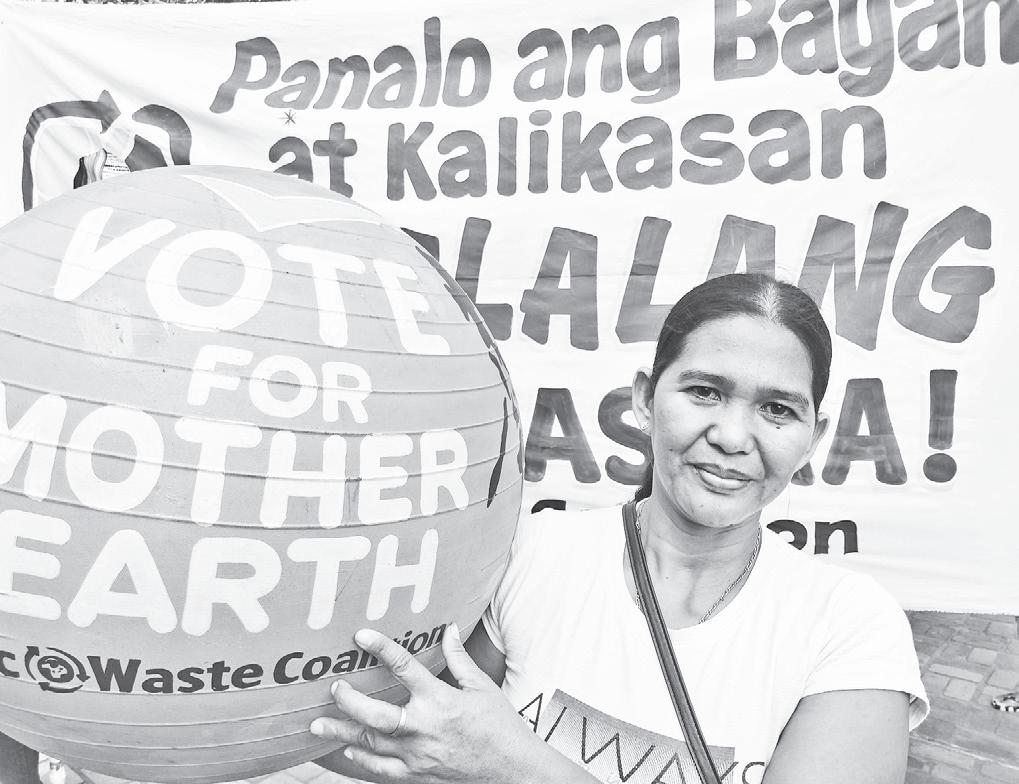
12. Eradicate graft and corruption in government
Alyansa Tigil Mina national coordinator Jaybee Garganera is dismayed that just a handful of people have responded to a survey conducted by a coalition of environmental, nongovernment, academe, and religious groups to press senatorial bets to open up on pressing climate and environmental issues.
Worse, he said, another survey, revealed that climate change, environmental issues like mining, coal pollution, garbage, were not among the top 10 among voter preferences.
“It’s very disappointing. The closest we saw related to the environment in the voter preference is energy. Even disaster is not on the top 10 list they want politicians to address,” he said in Filipino during a telephone interview on May 1.
Corporate accountability FOR Greenpeace and Marikina Kontra Agos, issues of corporate accountability and the concept of making polluters pay damages to climate-affected communities were on top of their green agenda.
More than a hundred young people from Marikina City issued the resounding call on local and national candidates to stand up for these two issues.
They likewise raised a local environmental concern—flooding in Marikina City because of climate change-triggered extreme weather and the environmental degradation that aggravated the problem.
Flooding and solutions
IN a statement released during the event, Marikina Kontra Agos said there are long-term green solutions to the flooding of Marikina that are not limited to infrastructure projects. It likewise challenged the city’s candidates to include the protection of the Marikina River system and the Upper Marikina Watershed into their platforms.

The group wants candidates to recognize that the annual overflowing of the river system requires the coordination of Pasig City and the provincial government of Rizal as the river system knows no political jurisdiction.
Wanted: Climate justice champions
“YOUNG Marikeños are going to elect leaders at a time when impacts of the climate crisis are causing more frequent and intense rainfall and extreme weather, such as super typhoons,” said Greenpeace Campaigner Jefferson Chua in a statement.
“Now is the time to choose leaders who will champion climate justice and hold those responsible for the climate crisis to account, and who will protect vital ecosystems to ensure that communities will be resilient in the face of climate impacts. By doing so, they can help secure a better future for themselves and the country,” Chua explained.
Greenpeace Philippines and Marikina Kontra Agos called on the electorate to support measures that facilitate climate justice, such as the pending Climate Accountability Bill, which aims to hold polluters responsible, secure reparations for affected communities, and pave the way for a corporate transition.
Specifically, Marikina Kontra Agos is calling for:
1. The implementation of a 50-year moratorium on all quarry and mining permits within and outside the Upper Marikina Watershed in Rizal
2. Commitment to sustainable, community-led reforestation efforts—not privatized initiatives and certainly not large dams
3. Reconvene the Alliance of Seven to collaboratively address flooding and develop comprehensive, sustainable solutions
Five-point agenda AT the national level, Greenpeace released the following five-point agenda for candidates:
1. Champion communities: Help build climate-resilient communities
2. Demand accountability: Make climate polluters pay
3. Support the Just Energy Transition: Ensure clean and just energy for all
4. Advocate health and wellbeing: Promote healthfocused climate policies
5. Put climate justice and climate action at the center of policymaking
Cavite green agenda
IN Cavite City, environmental advocates laid down their local green electoral agenda, including the ban on single-use plastics and a halt to seabed quarrying and reclamation projects.
The opposition to a court decision allowing commercial fishing within the 15-kilometer municipal waters was raised in a forum held in Dasmariñas, Cavite last month.
“We call on local and national candidates to commit to the green agenda and prioritize both social and environmental [concerns] alongside economic well-being. We also call on the public to vote for candidates who pledge to push for these environmental policies and programs once voted into office,” said Eileen Sison of the Green Coalition of Cavite (GCC) in a statement.
The organizations that crafted the Cavite Green Electoral Agenda are the GCC, EcoWaste Coalition, Elisea Youth for Environmental Sustainability (EYES), Kabitenyong Alyansa Laban sa Seabed Quarrying (Kalasag), Philippine Rural Reconstruction Movement, Philippine Rural Reconstruction Youth Association, and the Diocese of Imus Ministry on Ecology.
“Meaningful changes that address unjust societal conditions,

climate change, and environmental destruction can only be achieved if the environment and communities are at the center of people’s political decisions and of governance,” said Sam Malizon of Kalasag.
“The green agenda not only serves as a basis for electing candidates but also as a platform for exacting accountability from elected leaders,” Malizon added.
Youth leader Lord Noah Tucay of EYES asserted that they are committed to advancing the green agenda before and after the elections to ensure environmental protection for future generations.
The following stand as the central themes of the Cavite Green Agenda:
1. Protection of bodies of water
2. Waste management and pollution
3. Sustainable development of agriculture and fisheries for food security
4. Coastal resource management
5. Clean energy
6. Defending Cavite’s Mt. Palay-palay and other land resources
7. Preserving ecosystem and biodiversity
8. Climate change and disaster risk reduction
9. Protection of and human rights defenders,and; 10. Advancing participatory governance.
Power, electricity agenda IN April, the Power for People Coalition (P4P), together with sectoral representatives from community-based organizations, teachers, youth, and other sectors who engaged senators on their plight as power consumers, held a consumer forum at the St. Joseph’s College of Quezon City.
Dubbed “Powering the Future: A Townhall Forum on the Philippine Energy Landscape in the Context
of the 2025 National Elections,” they bared their power and electricity agenda.
“Power and electricity are a critical issue that senatorial candidates seeking to serve the public should not ignore. Today, consumers and communities across the country still bear the brunt of a power sector that perpetuates costly electricity, unreliable and anticonsumer services, and pollution. It’s high time to change this,” said Gerry Arances, convenor of P4P.
Organized as a contribution to Green Agenda 2025, an initiative for green elections led by the Catholic Bishop Conference of the Philippines, the event saw senatorial candidates Ka Leody de Guzman and Atty. Luke Espiritu of Partido Lakas ng Masa, and Teddy Casino and Mimi Doringo of Makabayang Koalisyon ng Mamayan championing the consumers’ power and electricity concerns.
“This election season is a critical time for Filipinos to use the power of their vote to shape our future as a country. Today, social, economic, ecological, and other crises abound, making life difficult for many of our countrymen, especially the poor and vulnerable…” said Bishop Gerry Alminaza, vice chairperson of Caritas Philippines and lead convenor of Laudato Si’ Convergence.
“It is very important that those who are seeking to serve the public as lawmakers are at the forefront of these conversations. We hope that facilitating dialogues with stakeholders, such as this, can truly help shape our power sector and our future for the better,” Alminaza added.
While most Filipino voters do not consider the current climate crisis and environmental problems as critical and pressing election issues, environmental and climate justice advocates and a growing number of like-minded individuals are making their presence felt in the midterm elections.
THE Philippine Space Agency (PhilSA), in partnership with the provincial government of Bulacan, conducted a three-day Pinas Workshop and Training on Space Science and Technology Applications (SSTA) for Disaster Risk Reduction and Management (DRRM) Malolos City in April. Pinas is short for PhilSA Integrated Network for Space-Enabled Actions toward Sustainability. Representatives from the Bulacan Provincial Disaster Risk Reduction and Management Office (PDRRMO), local government units (LGUs), and provincial offices participated in the training, which focused on space data mobilization in strengthening DRRM efforts.
Participants gained practical knowledge on flood mapping and monitoring, drought assessment, ground motion monitoring, and impact assessment using remote sensing and geographic information system. Through a series of hands-on exercises, they produced optical- and radar-based flood and drought maps.
To further support their initiatives, participating institutions received a geospatial data package containing land cover classification maps, satellite imagery, and agricultural drought outlook maps, among others. Participants were also introduced to open-source and freely available satellite data, particularly Sentinel-2 imagery from the Copernicus program, which they can integrate into their programs. In support of sustainable planning and decision-making, Roberts Marinas from the
Department of Human Settlements and Urban Development (DHSUD) discussed the role of SSTA in climate change adaptation, emphasizing the development of the Climate and Disaster Risk Assessment (CDRA). The CDRA aims to assess the potential impacts of hazards on communities and their assets, providing crucial insights for resiliencebuilding.
The training also featured technical presentations on remote sensing applications for DRRM, drone operations and their practical uses, and the importance of integrating field data into spatial analysis.
Participatory mapping activities were conducted to identify key environmental, agricultural, and DRRM concerns across different areas in Bulacan.
This initiative reflects the growing collaboration between national agencies and local governments, highlighting the critical role of space technology in building more resilient, adaptive, and data-driven communities.
Establishing linkages for local DRRM initiatives
THE conduct of the Pinas Bulacan Workshop and Training was made possible through the collaboration between PhilSA and the Bulacan provincial government, particularly the support of the PDRRMO, which initiated the request for partnership and specialized training.
This initiative highlights the critical importance of strengthening linkages between national agencies and local
governments to advance the application of SSTA in DRRM, ultimately building more resilient and adaptive communities.
Representing Bulacan Gov. Daniel R. Fernando, Chief of Staff Atty. Nikki Manuel Coronel emphasized the critical role of science-based approaches in deepening the understanding of our environment and enhancing the delivery of public services— especially during disasters—to ensure the safety and well-being of communities.
Bulacan DRRM Officer Manuel M. Lukban Jr., outlined the province’s strategic goals for integrating SSTA into local DRRM operations.
He emphasized how leveraging satellite data and geospatial technologies can assist in hazard monitoring, improve risk assessments, and strengthen the province’s
capacity for disaster preparedness, response, and recovery. This training was the first of the technical workshops and sectoral consultations aimed at fostering deeper engagement with potential end-users and partners in Bulacan, further advancing the integration of space data utilization into local DRRM efforts. The PINAS Project is an active network of institutions and individuals committed to promoting sustainability
PARIS—The French government accused a hacking group linked to Russian military intelligence of cyberattacks over three years, targeting the Paris Olympics French government agencies and companies.
A report released recently by France’s cybersecurity agency, ANSSI, outlined cyber incidents from 2021 through 2024, which it attributes to a group called APT28, also known as Fancy Bear. The report said the hacking aimed to collect intelligence, notably in the context of Russia’s war in Ukraine. France is among Ukraine’s most vocal backers, and its government is working to ensure that an eventual US-brokered peace deal doesn’t further embolden Russia and threaten Europe’s security.
The French Foreign Ministry said the hacking was linked to the Russian military intelligence agency GRU, and targeted French entities including a “sports organization linked to the planning of the 2024 Paris Olympic and Paralympic Games.” It didn’t identify the organization or detail the impact of the cyber-meddling.
The cybersecurity agency said other targets included those involved in aerospace, finance, national government ministries and local governments. It didn’t name them. More than a dozen reports in 2023 and 2024 pointed to an intensifying effort from Russia to undermine France through disinformation campaigns, particularly the Paris Olympics. Russian athletes’ participation in the Olympics has been curtailed for years because of the Russian invasion of Ukraine and state-sponsored doping.
The Russian Embassy in France and the Kremlin have denied any interference in the Paris Olympics.
Responding to the French announcement, Google Threat Intelligence Group chief analyst John Holquist said in a statement that “targeting of the Games by the GRU was heavily anticipated... Even though the games are a potent symbol of international cooperation, they are still the target of malicious intelligence operations.”
APT28 and the GRU have also been linked to global cyber intrusions, including in the 2016 US election, where they were accused of aiding Donald Trump by leaking Democratic Party emails
The French Foreign Ministry named a specific GRU unit, Unit 20728, as being behind the 20212024 cyberattacks. The cybersecurity

agency report also mentions unspecified attacks on entities in Ukraine, elsewhere in Europe and North America.
“These destabilizing activities are unacceptable and unworthy of a permanent member of the UN Security Council,” the Foreign Ministry said in a statement. “Alongside its partners, France is determined to use all the means at its disposal to anticipate, discourage and react to Russia’s malicious behavior in cyberspace.” AP
Sunnie and Jenny in action
The Philippines’ Sunnie Villapando and Jenny Gaviola celebrate a point during their match against Romania’s Beata Vaida and Francesca Ioana Alupei in the Volleyball World Beach Pro Tour Futures Nuvali on Friday in the City of Santa Rosa in Laguna. The Romanians won, 21-13, 21-14. NONIE REYES
LONDON—Transgender women will be banned from playing on women’s soccer teams in England and Scotland following a UK Supreme Court ruling last month, the sport’s governing body said before the weekend.
The Football Association said it had decided to change its rules that had allowed transgender athletes to play on women’s soccer if they had reduced testosterone levels. The Scottish Football Association made a similar decision that applies to competitive women and girls’ soccer.
The UK’s highest court issued a ruling two weeks ago that defined a woman for anti-discrimination purposes as someone born biologically female. The head of the Equality and Human Rights Commission said after the ruling that transgender women would be excluded from women’s toilets, hospital wards and sports teams. While the ruling was cheered by some feminist groups, it has been condemned by trans-rights groups who said it would have a broad and detrimental impact on daily life. The issue has been polarizing in the UK and beyond, particularly in the United States, where President Donald Trump has signed executive
orders to prohibit participation of transgender athletes in sports and to use a rigid definition of the sexes , rather than gender, for federal government purposes. The orders are being challenged in court
The FA said that its policy before Thursday had been to make the sport accessible to as many people as possible, but that it would make alterations if there were changes in law, science or the operations of “grassroots football.”
“We understand that this will be difficult for people who simply want to play the game they love in the gender by which they identify, and we are contacting the registered transgender women currently playing to explain the changes and how they can continue to stay involved in the game,” the FA said in a statement.
About 20 transgender women have been playing in English grassroots games this season.
“The people I know that are talking about this are saying: ‘Well, that’s it for football for me,’” said Natalie Washington, a member of the group Football v Transphobia. “Most people clearly don’t feel that they can go and play in the men’s game for reasons of safety, for reasons of comfort.”
Fiona McAnena, of the group Sex Matters, welcomed the English FA decision, saying it was long overdue.
“The FA has had ample evidence of the harms to women and girls caused by its nonsensical policy of letting men who identify as women play in women’s teams,” McAnena said. “The requirement to lower their testosterone tells you that everyone knew they were not women.”
McAnena said that every other sporting body needs to take similar action.
The group that oversees netball, an offshoot of basketball played mainly by women, said Thursday that its female category would apply to those who were born female.
England Netball said its decision wasn’t the result of the court ruling. It said that it would have three gender categories of participation: female, male and mixed, with the latter category allowing people to compete according to their gender identity. AP
CAMPAIGNERS take part in a rally organized by trans rights groups, trade unions and community bodies following the Supreme Court ruling on the definition of a woman in equalities law at Parliament Square in London recently. AP

LOUISVILLE, Kentucky—On a crisp, clear morning, a chestnut thoroughbred thundered down the dirt strip at Churchill Downs, his exercise rider leaning forward above the saddle. Other horse-and-rider pairs followed.
Dr. Will Farmer looked down from a viewing point, admiring the speed and agility of the 1,000-pound animals.
The whole world will have the chance to see horses in action here Saturday, when the Kentucky Derby shines a global spotlight on equine athleticism. It’s the subject of a growing body of research that cites a constellation of characteristics: big hearts, immense lung capacity, robust musculoskeletal systems and long, thin legs—all of which helped horses survive in the wild.

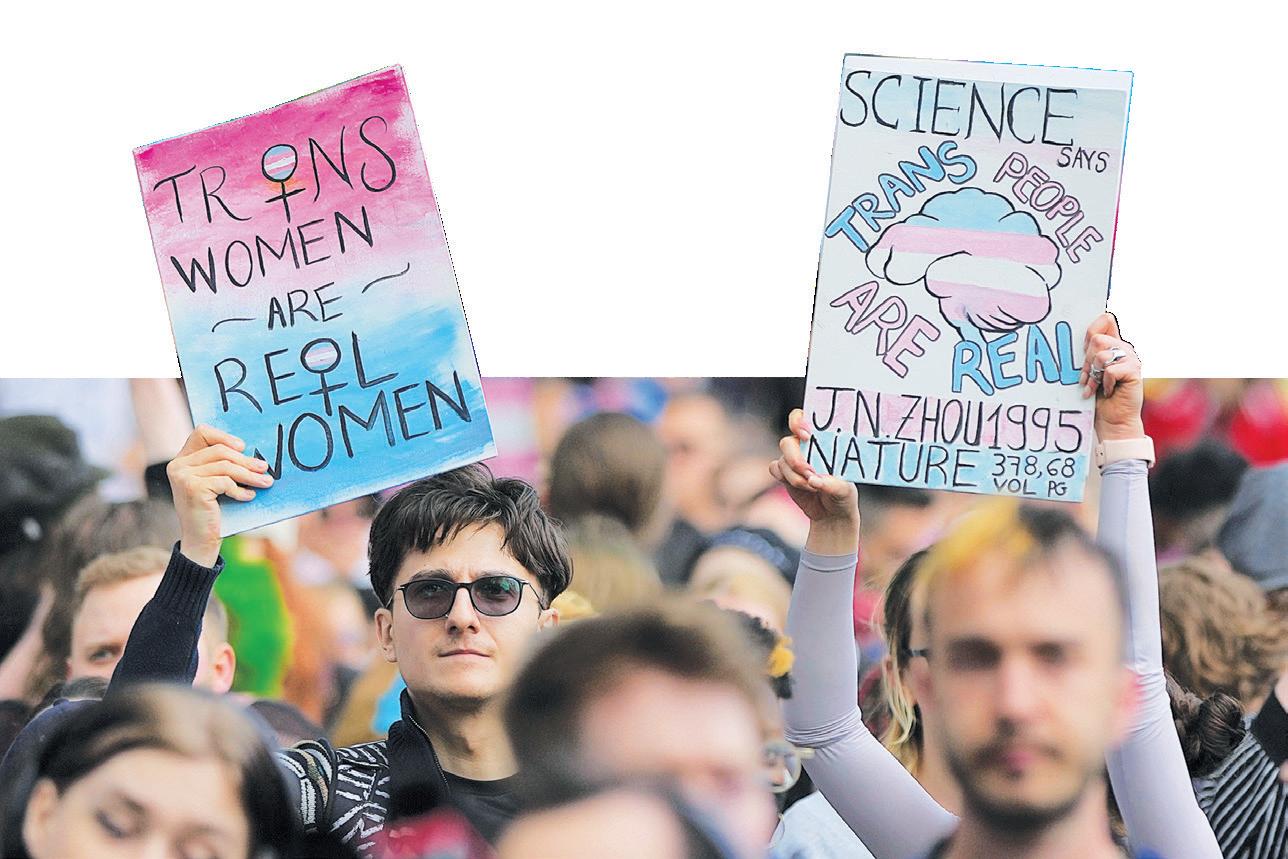
“It goes back to the roots: They are an animal of prey,” said Farmer, a veterinarian and equine medical director at Churchill Downs Inc. “That’s how they got away from being eaten.” Horses honed skills such as running, jumping and pulling as humans bred and trained them for various purposes over millennia. And the 151st Derby—horse racing’s most-watched event—will draw attention not only to the animals’ skills, but also to concerns about their treatment and health. Advocates have long raised concerns about deaths and injuries—calls that were amplified two years ago, when 12 horses died at Churchill Downs. There’s no doubt that war, agriculture and societies have been transformed by the human-horse relationship.

To
“Horses allowed us to circumvent our own biological limitations as a species,” said Timothy Winegard, a historian at Colorado Mesa University and author of a recent book, “The Horse.” “We combined our brains with the horses’ size, strength, stamina and speed to form the most unstoppable animal coalition.” What makes horses so powerful? A HORSE’S heart and lungs are the source of its extraordinary power. The heart averages 10 to 12 pounds (4.5-5.4 kg), or about 1 percent of the animal’s body weight, compared with half a percent for the typical human heart. Secretariat, the storied horse that won the Triple Crown in 1973, was found after his death to have a heart weighing more than 20 pounds (9.1 kg). AP
MIAMI GARDENS, Florida— George Russell had a frosty response Thursday to FIA president Mohammed Ben Sulayem claiming in an Instagram post he›s received “constructive feedback” from drivers that has the governing body considering relaxing the code of conduct that penalizes for cursing. Formula 1 drivers have been furious about Ben Sulayem’s rule that went into effect this year. When they learned of it last season, the Grand Prix Driver’s Association sent Ben Sulayem an open letter that Russell claims went unacknowledged.
So the Mercedes driver seemed surprised to learn Ben Sulayem is claiming there’s been an active dialogue.
Ben Sulayem wrote “I am considering making improvements to Appendix B,”—the rule that defines the penalties for a range of offenses that include physical violence to political statements, using foul language and any comments deemed to cause “moral injury or loss” to FIA. The base fine for an F1 driver is set out at $45,500 (€40,000). But Russell said Ben Sulayem’s post “doesn’t mean anything” unless the rules are actually changed.
“Obviously we want to see these things put into action, rather than saying ‘We’re considering things.’ You know, we all ‘consider’ a lot of things,” Russell said during media availability ahead of the Miami Grand Prix. “We [drivers] are clear we want changes. And once they are implemented, then we’ll comment. But for the time being it’s being ‘considered’—the words don’t mean anything until the change has been made.”
The new rule was received negatively by most of the racing series that the FIA oversees, including the World Rally Championship, where drivers complained it was a draconian approach.
This is an election year for Ben Sulayem, who was elected as president of the FIA after the 2021 season finale. Ben Sulayem is running for re-election and currently has no announced opponent. He’s had a bumpy relationship with the drivers from the start, as Lewis Hamilton and others pushed back on a rule banning the wearing of any jewelry in the race car. Further controversy followed with the firings of popular industry veterans, including F1 race director Niels Wittich, who was let go just before last November’s Las Vegas Grand Prix.
Asked last year if Ben Sulayem had the support of Hamilton, the seventime champion was blunt.
“He never has,” Hamilton said. Hamilton had a list of grievances regarding how the sport was dealing with its internal issues and even warned F1’s reputation was in danger.
“There is a real lack of accountability here, within this sport, within the FIA,” Hamilton said last year. “There are things that are happening behind closed doors, there is no transparency, there is really no accountability and we need that. The fans need that. How can you trust the sport and what is happening here if you don’t have that?”
When Ben Sulayem was asked about drivers being upset with the code of conduct rules, he said at the time it was “none of their business.”
Although Russell denied there had been dialogue with the FIA over the rule since the letter was sent last year, he did note there was extensive discussion at the drivers’ briefing at the season-opening Australian Grand Prix. AP
Horse hearts are built for exertion. The average horse can go from a resting heart rate of about 34 beats per minute to 220 or 240 while racing–faster than a human heart during maximum exertion.
“One thing that’s really unique about horses is that they have an incredible capacity to move blood around their bodies—their heart rate can go really high and still be safe,” said University of Connecticut researcher Sarah Reed, editor in chief of the journal Animal Frontiers. They also have a lung capacity of 60 liters—10 times that of humans.
“That massive lung field allows for oxygen to transfer from the air into their blood, which is vitally important for sustaining aerobic energy,” Farmer said. AP


BLOCKBUSTER MOVIE GUIDE 2025:
Here’s
MAY 4, 2025 | soundstrip.businessmirror@gmail.com
By Ica Hontiveros-Cheng
CURRENTLY in the middle of their ‘The Better Endings’ Tour, Marion Ravn and Marit Larsen of 2000’s girl duo ‘M2M’ sat down for a chat to talk about their upcoming EP and their comeback after a 23-year hiatus.
My fellow 90’s kids rejoiced when Norwegian duo ‘M2M’ announced a comeback tour and their Filipino fans who were still students when M2M were on the music charts; now have adult money to spend on concert tickets. And oh boy did they spend their hard-earned money, making the demand so great that concert promoter Wilbros Live had to add another Manila date, and open dates for Cebu and Davao as well.
"When we announced the first show in the Philippines,” Marit began, holding a cup of coffee in hand. “We didn't know if anybody was going to show up. We knew that people were still listening to our music and keeping it alive. We can see it in the streaming platforms but the fact that it sold out so quickly and that we had

Publisher :
T. Anthony C. Cabangon
Editor-In-Chief :
Lourdes M. Fernandez
Aldwin M. Tolosa
Concept :
Y2Z Editor :
SoundStrip Editor : Group Creative Director : Graphic Designers :
Jt Nisay
Edwin P. Sallan
Eduardo A. Davad
Niggel Figueroa
Chow Jarlego
Contributing Writers :
Tony M. Maghirang
Rick Olivares
Jill Tan Radovan
Reine Juvierre S. Alberto
John Eiron R. Francisco
Pocholo Concepcion
Francine Y. Medina
Justine Xyrah Garcia
Bea Rollo
Trixzy Leigh Bonotan
Bless Aubrey Ogerio
Photographers :
Bernard P. Testa Nonie Reyes
Y2Z & SOUNDSTRIP are published and distributed free every Sunday by the Philippine Business Daily Mirror Publishing Inc. as a project of the
The Philippine Business Mirror Publishing, Inc., with offices on the 3rd Floor of Dominga Building III 2113 Chino Roces Avenue corner
Dela Rosa Street, Makati City, Philippines. Tel. Nos. (Editorial) 817-9467; 813-0725. Fax line: 813-7025
Advertising Sales: 893-2019; 817-1351,817-2807. Circulation: 893-1662; 814-0134 to 36. www.businessmirror.com.ph
to add an extra show and then that there was actually a possibility for two more. It really enforced the idea that this is what we are really supposed to be doing.”
The best idea ever
“And we've done three shows so far and it does feel like a celebration.” Marit concluded smiling, the duo were in Hong Kong before the Manila stop of their tour.
Little did fans know that their reunion tour and comeback to music almost didn’t happen, if it weren’t for a chance meeting that came right out of a movie and that one could only call as destiny.
Dressed in a brown jacket with fringes, Marit recalled the moment: “It was a year ago in April in Oslo (capital of Norway) we both live there now. Marion had a flat tire on her car, I was running late so I stepped into this cafe I've never been in before to buy coffee for the guy that I was meeting to say 'I'm sorry for being late' and then we were there just the two of us in line. And that led to this. It felt like the universe was playing a trick on us. And it feels like the best idea ever.”
With already two tracks available Marion and Marit are set to release their upcoming EP Still In My Dreams and when I asked how they came up with the title. Marion laughed: “The title is an easter egg for the fans. So we don't want to answer that question,” she teased. “People would have to find out why.” Marion added laughing.
It’s magical!


Marit went on to explain: “But the EP contains 5 songs, five of our biggest hits that we have re-recorded and they are re-imagined versions, they feel like taking the great songs that they are (we can say that now that we are adults) and putting them in a landscape that is
more 2025. as a celebration and something to give to our fans for this anniversary tour that we are doing.”
WIththeupcomingEPbeingare-recordingoftheirhits,I hadtoaskwhatwasitlikerevisitingthesesongs23yearslater?
Marion answered: “It's really nice for us to revisit these songs. Because when you do re-recordings you re-discover

the songs too. Because you think more about: "Oh, that's why we chose that lyric, and why did we choose that chord. And you take the song apart and put it together again. And it's actually perfect for us to do that, before going on tour as well. Because you get so connected to the songs. Marit chimed in: “And since these are our songs, we were very young when we wrote them but we get to visit our song writing brains from when we were teenagers which is also kind of magical.”
Was there anything you wanted to do the first time around, when you wrote the songs that you didn't get to do? But we’re able to do them now.
"Yes!" Marion exclaimed. "It's actually playing the concerts. Last time we only did interviews and showcases and we never got to go on tour. And we've always dreamt about going on tour and playing these songs live and that's exactly what we're doing now."
"On our terms and how we want to do it." Marit agreed.
With their comeback tour being christened as The Better Endings Tour I had to dig into how that name came about. Mari answered: "It's about taking back what was always great about M2M, kind of ending on a better note. Being in charge of our story, celebrating the adventure that it was. It was a whirlwind (adventure) and it ended very quickly. But we've had great success and we've reached so many people, we've been the soundtrack of so many people's lives. And they've stayed with us all this time as well. So it already feels like a better ending.”
As to their fans who made a four-day Philippines stop possible, this is what they had to say:
“Thank you for keeping our music alive all these years, and thanks to you guys in the Philippines we can do this. We can come and do a concert for over 8,000 people two nights in a row in Manila, Cebu, and Davao. And it's really a dream come true for us. So thank you. We can't wait to see you!”
The Better Endings Tour will begin in Manila on May 1 and 2 at the Araneta Coliseum, and will continue on May 3 in Davao, and May 4 in Cebu.
M2M’s upcoming EP Still In My Dreams will be released on May 9, 2025 and will be available to stream on digital platforms.
Story and photos by John Eiron R. Francisco
Despite the fame and milestones they’ve reached,
P-Pop pioneering group SB19 stays firmly grounded, believing that true joy comes from appreciating everything — a lesson they learned from having once had nothing, and now made even sweeter by sharing their success with others.
In an exclusive interview with BusinessMirror’s SoundStrip one day before the group released its official music video for their singles, “DUNGKA!” and “Time,” both part of Simula at Wakas, SB19’s main vocalist and lead dancer Stell emphasized that there’s no reason for them to change who they are. While their lifestyle, needs, and wants may have evolved over time, he said their attitude and character have stayed the same — rooted in the knowledge of where they came from.
“Dahil alam naming galing kami sa wala, mas binibigyan namin ng halaga kung anong meron kami ngayon. Ayaw na naming mawala pa ’yun,” he shared.
This sentiment was echoed by Josh, the group’s lead rapper, lead dancer, and subvocalist. “ Nagstart kamingwalang-wala… Kaunti lang, happy ka na. But now na meron ka na, you always get to appreciate everything,” he shared.
Josh pointed out that things which once seemed out of reach, like eating fancy foods, are now more accessible—but instead of taking them for granted, the group has become more thankful for them.

mga bagay-bagay,” he said.
“Pero ngayong meron na kami, mas naenjoy namin ito at mas nababahagi pa namin sa iba,” he added, underscoring that their sense of fulfillment is now deeper, not only because of what they have, but because they can share it with others.
and thematically with every project, constantly offering new dimensions of their artistry to surprise and challenge their fans.
Yet despite the ambitious concepts and occasional limitations in resources, SB19 has consistently managed to execute their vision successfully.
statement and a call to action. It’s a celebration of individuality, with each member showcasing their unique persona. But beyond that, it’s also a collective roar—a message rooted in today’s realities and aimed at sparking conversation.
The music video captures that spirit of movement, placing the group in the center of a symbolic uprising that starts, fittingly, in the streets. It's a nod to where true change often begins—not behind closed doors, but in everyday spaces, with everyday people.
To amplify that message, SB19 brought in a powerhouse ensemble of guest stars: Mimiyuuuh, Maymay Entrata, Alodia Gosiengfiao, Sassa Gurl, Jayat, Kween Yasmin, Malupiton, Ghost Wrecker, Shehyee, Smugglaz, Pat Lasaten, Agnes Reoma, and Vice Ganda. Their presence, the group said, wasn’t just for show—it deepened the song’s impact.
“We invited people who embody the message,” SB19 explained. “They’re artists and personalities who also want to challenge the system, who aren’t afraid to speak up. The timing, the visuals, the energy—it all came together. It felt right.”
And clearly, the message resonated. Within a week of its release, “DUNGKA” had already racked up over 1 million streams on Spotify and 3.3 million views on YouTube—a proof to the group’s ability to merge art with activism in a way that clicks with audiences.

‘No Gimmicks, Just Greatness’
Meanwhile, SB19’s leader, Pablo, reflected on the changes in their outlook since their early days. “Noongwalang-walakami,na-enjoy nanaminang
Their passion, honed by years of perseverance, is clearly reflected in Simula at Wakas, the final installment following 2021’s Pagsibol and 2023’s PAGTATAG. According to Stell, the group has consistently made it a goal to evolve both musically
Stell noted that their latest music videos achieved a "perfect balance"—avoiding anything that felt forced or cringeworthy, while still delivering a polished and well-thought-out approach.
Nowhere is this more evident than in “DUNGKA,” one of the new project’s standout pieces. Bold, unflinching, and brimming with energy, the track serves as both a musical
Balancing this boldness is the release of “Time,” a quieter but equally powerful counterpart. Directed by 1032 Lab, the music video strips away extravagance in favor of emotional honesty. It zooms in on the simple but profound truth that time is fleeting—and it’s up to each of us to use it wisely.
“The visuals weren’t the focus this time,” the group explained. “We wanted the message to stand out. Everyone deals with time, but not everyone sees its value until it’s too late.”
The result is a deeply personal piece that connects across generations and backgrounds. Scenes of daily life—family meals, quiet moments, unsaid goodbyes—paint a picture that feels both specific and universal. With over 3.4 million views and 1.2 million streams, “Time” proves that even in stillness, SB19 can make waves.
Together, “DUNGKA” and “Time” show two sides of the same coin: urgency and reflection. One moves the body, the other tugs at the heart. And both are unmistakably SB19—fierce in intention, honest in delivery.
'Simula at Wakas' may mark the end of a trilogy, but it’s far from a conclusion. If anything, it’s a bold signal that SB19 is just getting started. With each project, they continue to prove that their music isn't just for listening—it's for feeling, thinking, and, most importantly, acting.
“Para sa ‘Simula at Wakas,’ sobrang excited kami for the ending, but at the same time, inaanticipate rin namin what’s next,” Pablo said.
By The Associated Press
ETHAN Hunt’s last mission? A new Superman? Hollywood is pulling out the stops this summer movie season, which kicks off with the recent release of Marvel Studio’s Thunderbolts*
The month of May also brings big studio releases like a live-action Lilo & Stitch, Mission: Impossible 8 and a new Wes Anderson film. June heats up with race cars in F1, adventure in How to Train Your Dragon, and zombies in 28 Years Later. Meanwhile, July is supercharged with Jurassic World Rebirth, Superman, and Fantastic Four: The First Steps Here’s The Associated Press’ guide to help make sense of the many, many options in theaters and at home.
May 9
Friendship (A24, theaters): Paul Rudd and I Think You Should Leave comedian Tim Robinson star in this absurd, comedic film about male camaraderie.
Nonnas (Netflix, streaming): Vince Vaughn stars in this Stephen Chbosky-movie based on a true story of a Brooklyn guy who hires Italian grandmothers to be the chefs at a restaurant after the loss of his own mother. Susan Sarandon, Lorraine Bracco, Talia Shire and Linda Cardellini also star.
May 16
Final Destination: Bloodlines (Warner Bros., theaters): It’s been 25 years since the Final Destination franchise kicked off and they’re still finding new horrifying ways to kill off their characters.
May 23
Lilo & Stitch (Disney, theaters): This live-action reimagining of the 2002 classic about orphaned
THE Marvel Cinematic Universe (MCU) closes Phase 5 with the highly chaotic and highly unlikely ensemble film Thunderbolts*, now showing in cinemas nationwide. Former villains and assassins take center stage as the MCU answers, “Now that the Avengers are gone, who will protect Earth?”
This group of misfits, ticking timebombs sure don’t dream of becoming legendary heroes themselves. But redemption and a chance to restart? Those are more up their alley. After commiting crimes against humanity, these antiheroes now seek redemption by joining this dysfunctional team of misfits.
Leading the pack is Yelena Belova (Florence Pugh), a former assassin for General Dreykov under the Black Widow program, who is back on the battlefield fighting for a different cause.
Hawaiian sisters who unknowingly adopt an alien was directed by Marcel the Shell with Shoes On filmmaker Dean Fleischer Camp. Sydney Agudong, who plays older sister Nani, said, “The beauty of this movie is that it highlights the idea of Aloha and Ohana and the family dynamics that happen here along with the aliens and the Hawaiian roller coaster ride.”
Mission: Impossible – The Final Reckoning (Paramount, theaters): Nothing ever really ends in the land of franchise filmmaking, but the “final” in the title suggests this could actually be Tom Cruise’s last ride as Ethan Hunt. Even if it isn’t, audiences can trust it’ll be full of death-defying spectacles worthy of the big screen.
May 30
Karate Kid: Legends (Sony Pictures, theaters): Jackie Chan and Ralph Macchio unite for the newest Karate Kid film, set three years after Cobra Kai and focusing on a new kid, Li, played by Ben Wang.
The Phoenician Scheme (Focus Features, theaters): Benicio del Toro stars as one of the richest men in Europe, and father to nine sons and one daughter (Mia Threapleton), in Wes Anderson’s newest film, featuring a typically starry ensemble including Tom Hanks, Michael Cera, Scarlett Johansson, Riz Ahmed and Benedict Cumberbatch.
June 6
Ballerina, (Lionsgate, theaters): Ana de Armas leads this “John Wick” spinoff about a deadly (and classically trained) assassin.
The Life of Chuck (Neon, theaters): This is not your typical Stephen King adaptation. Mike Flanagan directs the sentimental and supernatural story about the life of an ordinary man named Charles Krantz, told in three chapters. Tom Hiddleston, Mark Hamill, Chiwetel Ejiofor, Mia Sara, Benjamin Pajak and Karen Gillan are among the large ensemble cast.
June 13
How to Train Your Dragon (Universal, theaters): Unlike most live adaptations of animated movies, filmmaker Dean DeBlois is behind both. DeBlois said their goal was to make the film “really immersive,” to dial up the sense of urgency and peril and “to just pull the audience in and make
them feel like these dragons are real, that you could own one, you could fly on the back of one.”
Materialists (A24, theaters): Dakota Johnson plays a matchmaker torn between two prospects (played by Chris Evans and Pedro Pascal) in love story from Past Lives filmmaker Celine Song. “I really tried in this film to be really honest about the marketplace of dating, as the people actually experience it and live it today.” Song said.
June 20
28 Years Later (Sony Pictures, theaters): The original team behind 28 Days Later, including director Danny Boyle and writer Alex Garland, return with a new entry featuring Aaron TaylorJohnson, Jodie Comer and Ralph Fiennes.
Elio (Disney/Pixar, theaters): This intergalactic adventure centers on an 11-year-old earthling (Yonas Kibreab) who is abducted by aliens and assumed to be a world leader. Oscar-winner Zoe Saldaña is part of the voice cast.
June 27
F1 (Warner Bros./Apple, theaters): Brad Pitt plays “the best that never was,” F1 driver Sonny Hayes, who’s recruited to mentor a young upand-comer (Damson Idris) in this high-octane film from Top Gun: Maverick filmmaker Joseph Kosinski. Real racing cars were used, driver Lewis Hamilton consulted and a new camera system was developed to give audiences an immersive experience.
July 2
Jurassic World Rebirth (Universal, theaters): Filmmaker Gareth Edwards (a Jurassic Park superfan and the director of The Creator) is ushering in a new era of Jurassic movies and harkening back to the Steven Spielberg originals in this film with Scarlett Johansson, Mahershala Ali and Jonathan Bailey. Much about the film is being kept top secret, but Edwards said David Koepp’s script read like a love letter to Spielberg’s early work. Edwards said, “It’s like one giant roller coaster ride and once it gets going, it sort of doesn’t stop.”
July 11
Superman (Warner Bros., theaters): James Gunn is ushering in a new era of Superman, with a fresh face in David Corenswet and the promise
that he’s different than what audiences have seen before. Gunn told the AP that this is “a Superman that’s both more grounded in his own personality and his relationship, which is much more complex than has been in the past. There’s romance with Rachel Brosnahan’s Lois Lane, and a “pretty scary” Lex Luthor in Nicholas Hoult. “He’s actually going to kill (Superman),” Gunn said. “And that’s cool to see.”
July 18
I Know What You Did Last Summer (Sony Pictures, theaters): Jennifer Love Hewitt and Freddie Prinze Jr. reprise their roles from the 1997 slasher in this new installment featuring an eerily similar situation and a cast of pretty young up-and-comers including Madelyn Cline, Chase Sui Wonders, Jonah Hauer-King and Tyriq Withers.
Eddington (A24, theaters): Ari Aster re-teams with Joaquin Phoenix for this film about a standoff between a small-town sheriff and a mayor in the early months of the COVID-19 lockdowns. Pedro Pascal, Emma Stone and Austin Butler also star.
July 25
The Fantastic Four: First Steps (Disney, theaters): Pedro Pascal, Vanessa Kirby, Joseph Quinn and Ebon Moss-Bachrach unite to play “Marvel’s first family” in this retro-futuristic world set in 1960s New York. Director Matt Shakman ( WandaVision, It’s Always Sunny in Philadelphia) said they are the only superheroes in their world and are the leading lights of their age. While the scale and world building were on another level, Shakman said, “it’s also no different from all of the great comedies and dramas that I’ve done—in the end, it comes down to character, to relationships and to heart and humor.”
Happy Gilmore 2 (Netflix, streaming): Adam Sandler returns to the green (and one of his most beloved roles) after almost 30 years. “The first one is so iconic, we all kind of knew the world that we were stepping into,” said Conor Sherry, who plays one of his sons. “We were like the newest additions to a long, long, long family.”
n Cover photo by Tima Miroshnichenko on Pexels. com
She is joined by Bucky Barnes (Sebastian Stan), a former Hydra-brainwashed assassin who eventually turned his life around to fight for good as the congressman of Brooklyn and will be forced to jump back into action in Thunderbolts*. The team also includes Alexei Shostakov/Red Guardian (David Harbour), Ava Starr/Ghost (Hannah John-Kamen), John Walker (Wyatt Russell), and Antonia Dreykov/Taskmaster (Olga Kurylenko).
The person responsible for assembling this chaotic team? Valentina Allegra de Fontaine (Julia Louis-Dreyfus), whose real motives remain a mystery. Does she have ulterior and personal motives for assembling a team of assassins, or is she an earnest patriot who wants to ensure the safety of her people?
Director Jake Schreier, inspired by stories of broken teams and unlikely bonds, pitched a

bold vision blending grit, humor, and emotion. “[Thunderbolts* is] not just big superhero action,” he says, “but a real emotional resonance—the need for connection and the fight to overcome the darkness within.”
Don’t miss the clash of redemption, revenge, and raw power as this unlikely team fights not just their enemies, but their own dark pasts. Watch the ultimate antihero rumble unfold in Marvel Studios’ Thunderbolts*, now showing in cinemas nationwide. Book your tickets now at https://www.disney.ph/movies/thunderbolts.
